My Audio Systems Through the Ages
A harmless (if pointless) trip down memory lane ... I have loved music and been fascinated by
equipment that can reproduce it since childhood. All in all, it has been one of the most
important parts of my life and certainly had a major effect on other parts of my life -- for
example, it led to a love of electronics and physics which, in turn, were critical factors
in determining how I have earned my living (albeit somewhat indirectly).
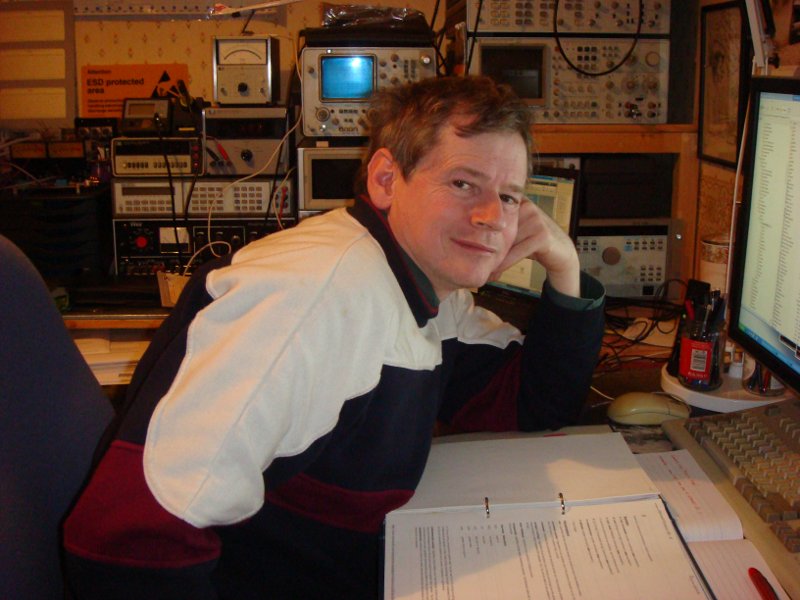
I feel privileged and very lucky to have lived when and where I have and to have been able to
(over?) indulge my interest in these things, and to have seen how things have developed over
the years. These notes are another piece of self-indulgence. I've enjoyed recalling these things,
though.
Contents
1969 - 1970

In 1969 (I think) my parents bought this Sobell radiogram. I was 10 at the time.
Before that, the only music
in the house came from various transistor radios. Over the years, we all had a lot of fun
with this thing. The picture above
is of the exact same model as we had, but it comes from an E-Bay sale (ahem!). Information
on these seems almost nonexistent, so I can't quote a model number or anything. It was a
nice piece of furniture and sounded OK to me at the time.
Visits to secondhand record shops were frequent ... purchases varied from
"Kismet" and Phil Harris to Beethoven (always a favourite) and Mendelssohn.
The records we bought inevitably came pre-scratched ... but don't they always?
Although no one in the family was musical (none of us could play an instrument and we knew
very little about musical history or theory), we all enjoyed a wide variety of music,
and I came to like a huge range of disparate types. This "open attitude" has remained with me,
for the most part. I now know rather more about music than I did back then, although I still
can't play a note!
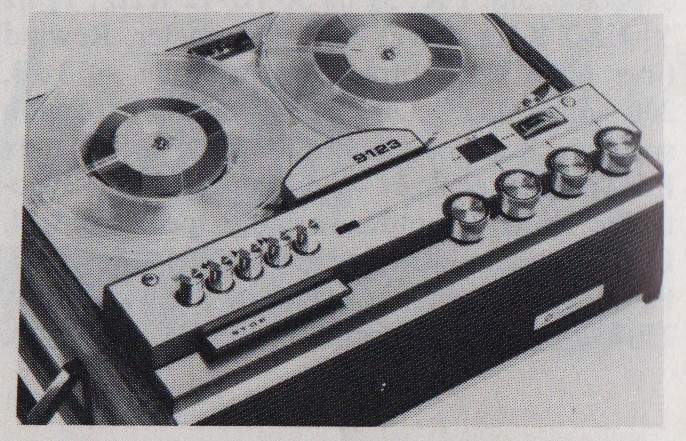
This Pye 9123 tape machine
arrived for Christmas 1970! By this time, I had seen a ReVox A77 Mark I at school and
I really wanted a tape recorder. This was not exactly an A77, but it was great at the time.
A single motor, mono 4 track machine running at 1-7/8 or 3-3/4 inches per second
with a signal to noise
ratio of about 45dB. An add-on unit converted it to stereo operation, but we never got that.
I seem to recall we successfully plugged it in to the back of the
Sobell with a DIN plug cable although a lot of recording was done with the microphone it
came with. Sadly, this machine is long gone. They still turn up on E-Bay occasionally and a
full replacement belt set is available. It is basically a re-badged and re-clothed
Philips model (perhaps N4308?).
This humble machine started a life long love of analog tape machines in particular and
recording devices and systems in general.
Total system cost (Sobell and Pye) was maybe £200. In 1970 pounds though. According to:
this site this is equivalent to a staggering £2700 today!
Go to top ...
1977 - 1980

My first attempts at DIY audio ... starting with a Grundig Yacht Boy 210 radio (bought
by my father for us to use on a long road trip holiday to Yugoslavia in 1972), a
Bang and Olufsen Beocord Stereomaster 610T tape machine (1963) and a
Garrard SP-25 turntable (both bought second
hand from the "bargain pile" in a hi-fi shop in Kettering). More information
on the Stereomaster can be found here.
I built a stereo decoder for the
Yacht Boy, tapping in to what I thought was the appropriate place.
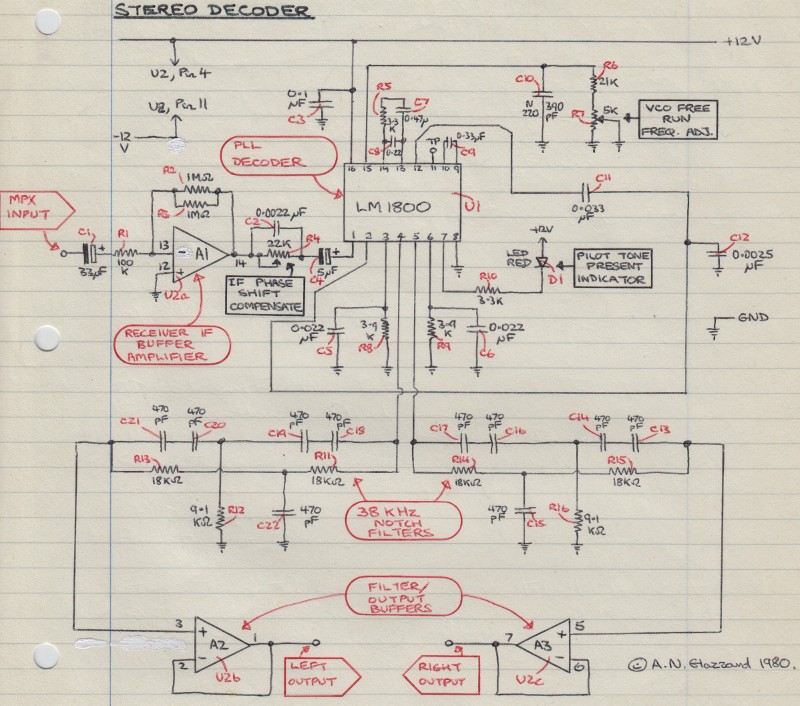 It sort of worked! A very
crude pre-amp (of sorts) for the Garrard never really worked well (to say the least!). Mind you,
neither did the Garrard from what I recall. It had a crystal cartridge which certainly didn't
help (although it meant the pre-amp didn't have to do much, in theory ... but I still failed
to make it work correctly).
This put me off vinyl for life!
It sort of worked! A very
crude pre-amp (of sorts) for the Garrard never really worked well (to say the least!). Mind you,
neither did the Garrard from what I recall. It had a crystal cartridge which certainly didn't
help (although it meant the pre-amp didn't have to do much, in theory ... but I still failed
to make it work correctly).
This put me off vinyl for life!
The centrepiece
of the "system" was the Beocord. This did work quite well, considering how little it cost (£10
I think!). Various (lousy) speakers were plugged in to the Beocord's power amps. Fun (of a kind)
was had with this setup. Sadly, the Beocord's motor stopped working. This was almost
certainly a phase shift capacitor issue, and could probably have been fixed easily, but I didn't
know that at the time. I ended up reluctantly throwing it away as a result of various turbulent
events around 1980-81. It was a fine machine. I came across the circuit diagram for it recently
and a scan of it (as a PDF file) can be found here. Maybe someone
still has a Stereomaster they want to repair!
The Garrard went the same way as the poor old tape deck
(but with a lot less reluctance). The Yacht Boy I
still have (although it is on long term loan to a friend). It still works well. The stereo decoder
is long gone though!
The most important factor at this point was the requirement for near zero cost! Total "system" (hah!)
cost was maybe £30 (not including the Yacht Boy, which was quite a pricey item in 1972). In today's
(2014) money, that is £133.
My musical tastes broadened to include punk, "new wave" and prog rock. Yes, I know
followers of punk and prog rock are supposed to loathe each other -- but I just don't
accept all this "genre" nonsense. You either like a piece of music or you don't. The one
thing I don't like about "classical" or "serious" music is the snotty nosed attitude some of its
adherents have towards all other forms (which they tend to lump together as "pop" -- perhaps
not realizing that some of it could hardly be described as "popular" in the strict sense of
the word). Fortunately, this "snottiness" has become less prevalent, although it can still
be observed occasionally (sadly, sometimes on the otherwise excellent BBC Radio 3).
Go to top ...
1987 - 1990
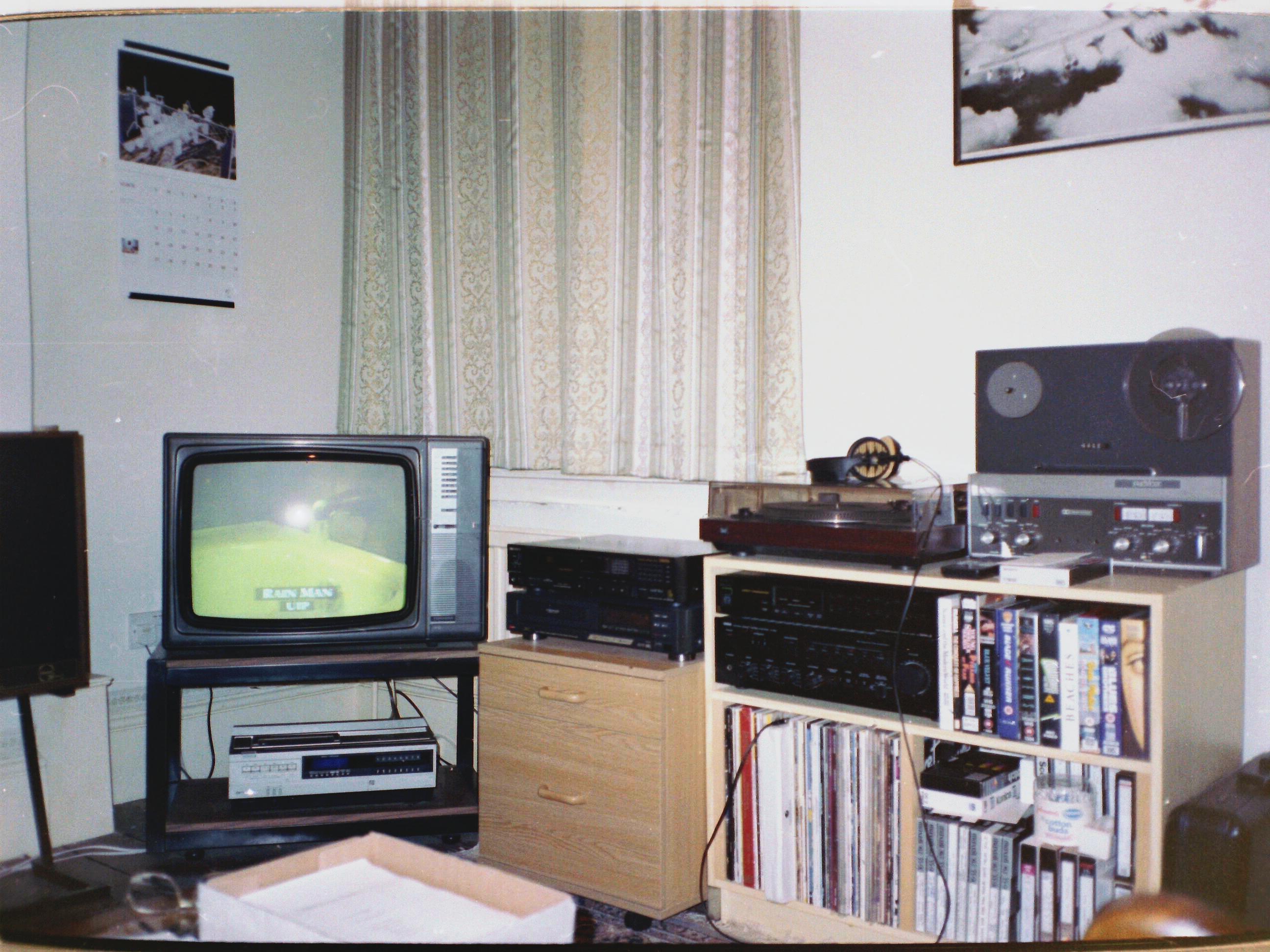
In 1987 I purchased my first real "hi-fi" system. I had a job that paid fairly well,
so buying a proper "budget system" seemed like a reasonable thing to do. The tuner and
tape deck were not the usual budget items though.
- Tannoy Mercury M20 speakers from Sevenoaks HiFi. Excellent small loudspeakers IMHO.
They won several awards for "budget models" back then - not that that means anything
(such reviews are rarely worth the paper they are written on). I eventually gave them
to a local pub (where they didn't last long, unfortunately). I seem to recall they
cost about £100.
- Onkyo amplifier from some discount shop in London. Can't recall the model number.
It worked well for me for a decade or so though. The switches got noisy around 1997,
prompting changes. About £75? I sold this at a charity sale for £10.
- Sony ST-S444ES Tuner. A cracking FM tuner! It would stand up against the best of
today's offerings, I suspect and it wasn't expensive for what it was (£200?). I eventually
gave this to an aunt who used it for many more years.
- Sony CD (CDP-750? Not sure, but I think so). I do remember getting this heavily
discounted from some shop in Tottenham Court Road. I think I got it for £150. This
also went to my aunt and had a long life.
- Dual CS-505(?) turntable. Also from Sevenoaks HiFi. This was another highly recommended
budget model of the time. About £100? It worked well. The records still all
came pre-scratched... Not sure where this went, but I no longer have it.
- Sennheiser HD-420 headphones. I still have these, but haven't used them for a good
20 years or more.
- The famous ReVox A77 Mark III Dolby tape machine. I still own this (of course). Much
loved, often used and from time to time serviced and repaired (by me)! See several other pages
on this site for (much) more information. Bought in 1986 for £350 from a shop called
Tune Inn in Hither Green, South London.
- Video gear includes a 1982 Toshiba TV which went slowly green over the years (a great
set though), a 1982 Sharp VTC-5000 Betamax VCR (which I still have, and still works after I did
some repairs a couple of years ago) and a JVC VHS machine (which never worked right and got
stolen in 1991 ... the thieves didn't take the CD player sitting on top of it
... they only wanted the VCR). All video was analog (PAL format), of course, broadcast TV
coming via ye olde aerial. Being in a fairly urban area at this time, I did have (analog) cable TV
for a year or so. Having access to 30 or so channels was quite a shock after being used to 4!
Cable TV faded to noise every time there was heavy rain though! It was distributed to the local
area via a microwave link.
Total core system cost was less than £500 (not including the A77). In today's prices that is:
£1228. Sounds about right. You could get an equivalent system today for £750, I think, although
the "source" components would be very different (computer based storage with a DAC for ripped
CD replay and streaming audio services, I would suggest). Excellent
"budget" systems can be put together for under £1000. With carefully chosen components, such
systems can have very few compromises and can sound as good as anything providing very high
sound levels and deep bass are not required.
Unfortunately, the current hi-fi press is entirely useless and gives
essentially no reliable information to help you pick the best components.
With this system, I started to become very interested in early and baroque music. Music from
these periods probably form the majority of my music collection.
Go to top ...
1997
Minor changes were made to the above system. The Onkyo amplifier was replaced with
an Arcam Alpha 8. This was a nice straightforward amp which I later passed on to my aunt
to partner the Sony tuner and CD player. I also bought some fancy headphones: Sennheiser HD-600's
which I still use.
I also bought my first portable audio system - a Sony TCD-D100 DAT Walkman. I found Digital Audio Tape
very appealing at the time. It was capable of very good results, although there have been reports of
major compatibility problems when playing back tapes on machines other than the one used for recording.
I later bought a Sony DTC-A6 (non portable) DAT machine and never had any difficulties exchanging
tapes between those two. But it was an issue in general, apparently. DAT uses helical scan technology
(like most video recorders) and it has the potential for "tracking adjustment" problems just like they
do.
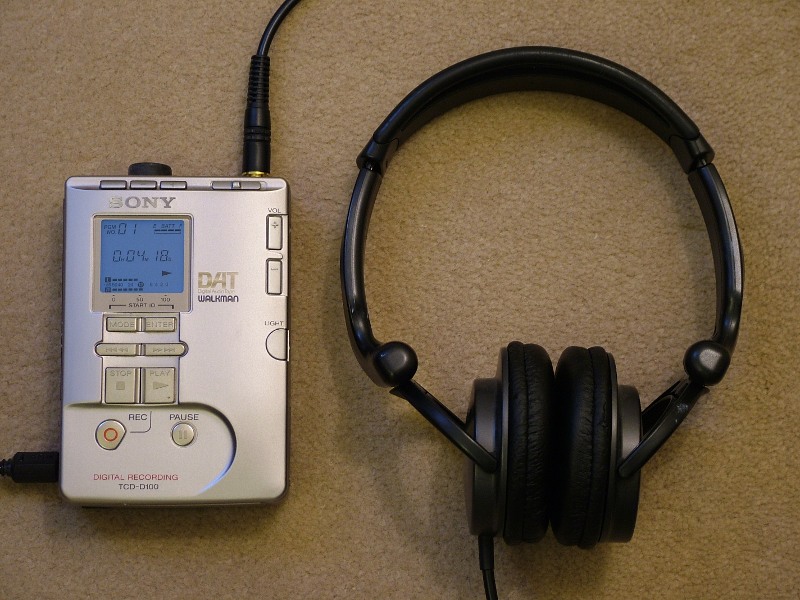 The headphones are Sony MDR-V400s. They sound very different from the Sennheiser HD-600s,
but both sound good. The MDR-V400 I would say greatly (over)emphasises the bass ... but they are
very usable. The only problem with the TCD-D100 is the rate at which it gets through batteries! You
can get about 1.5 hours of use out of a set of 4 AA batteries. If used for field recording (wildlife,
etc.) it really needs a separate battery pack. I still have, and occasionally use, this equipment.
It is a beautiful example of Sony at its very best -- a marvel of miniaturization and precision
engineering.
The headphones are Sony MDR-V400s. They sound very different from the Sennheiser HD-600s,
but both sound good. The MDR-V400 I would say greatly (over)emphasises the bass ... but they are
very usable. The only problem with the TCD-D100 is the rate at which it gets through batteries! You
can get about 1.5 hours of use out of a set of 4 AA batteries. If used for field recording (wildlife,
etc.) it really needs a separate battery pack. I still have, and occasionally use, this equipment.
It is a beautiful example of Sony at its very best -- a marvel of miniaturization and precision
engineering.
The first MP3 player appeared in 1998 (in the U.K. anyway). The competition in 1997 was CD or
Mini-Disc "Walkman". Mini-Disc was actually an excellent choice in many ways.
Late in 1997, I sent my ReVox A77 off to some "expert" for refurbishment. This didn't work out
too well, as documented in this page.
Some things were improved, but it still wasn't perfect. It
would be another 10 years before I finally got down to sorting it out myself.
Go to top ...
1999 - 2003
By this point, I was getting ambitious! I felt I could afford a "high-end" system ... although
this is definitely not "high-end" by today's standards as far as purchase price
is concerned! I was convinced that the
right way to design audio equipment was to keep it as digital as possible for as long as possible.
One company stood out amongst domestic hi-fi manufacturers with this goal in mind: Meridian. Their
"digital loudspeaker systems" made perfect sense to me. They still do, although I'm not sure
I would go down exactly this route again if I were to replace my current system.
In February 1999
I bought a pair of DSP-5000 digital loudspeakers with 24bit/96kHz upgrades. These remain the core
of my current main system. They take in an S/PDIF digital audio signal, apply volume control to
it, feed it through crossover filters (implemented in a DSP system)
and feed the result to DAC's with individual 75W
power amplifiers for each of the three drivers. Audio remains in the digital domain until the
last possible point: just before the drivers.

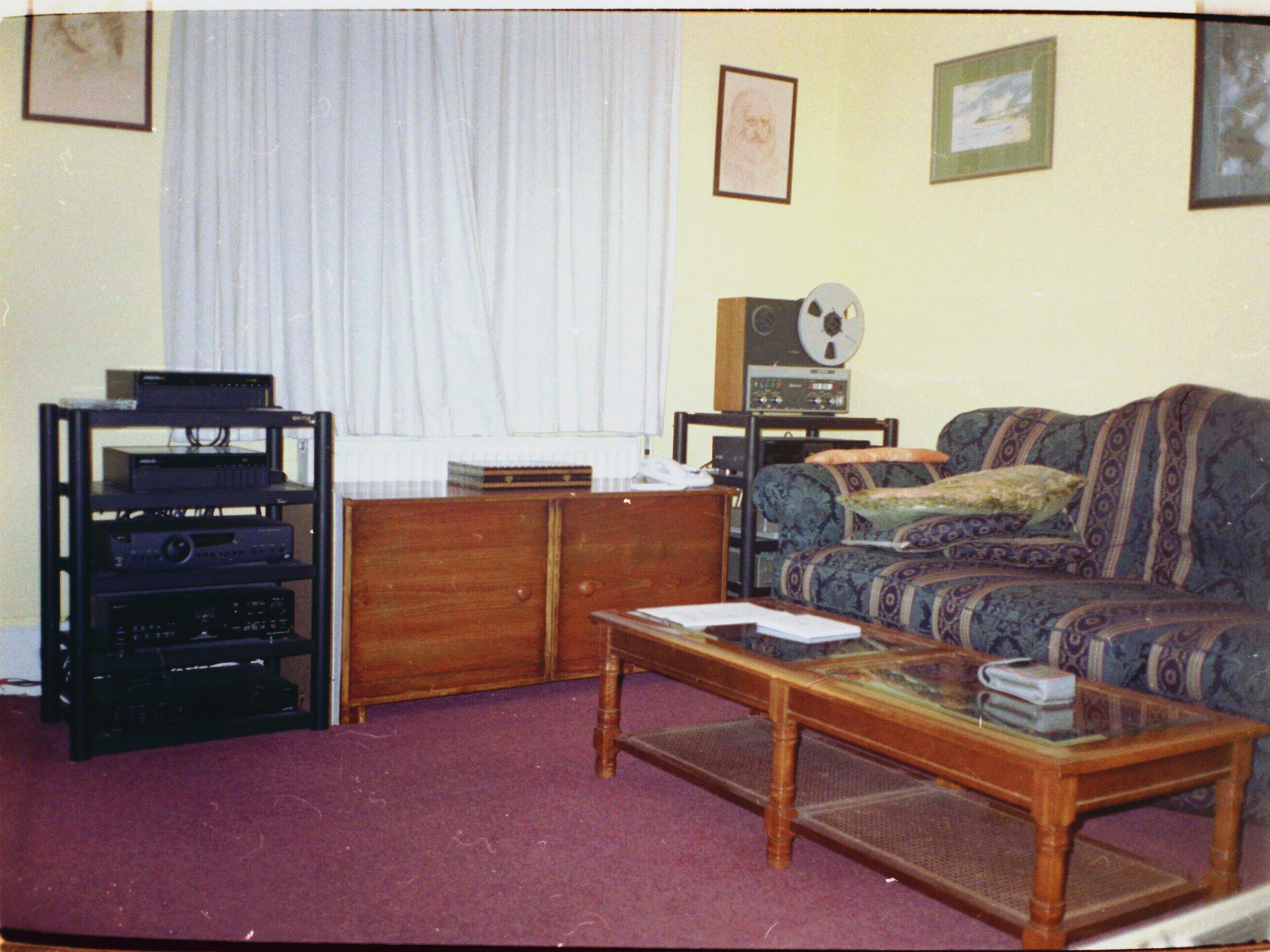
Other equipment in the 1999 period included:
- Meridian 562V Controller (essentially a digital pre-amp with an A-D converter that
could be switched to take input from various analog sources). This also controlled
the DSP-5000's via a Meridian Comms link.
- Meridian 506 CD Player (the digital output went direct to a 562V digital input).
- Sony DTC-A6 DAT tape machine (interfaced with the 562V by S/PDIF digital connections).
- Audiolab 8000T FM/AM tuner. Another excellent tuner, by the way.
The Meridian gear was bought from Unilet in Maidstone (still there, but under a different name, I think).
This setup came in at somewhere around a hefty £7,500. This is near the upper limit of what
I would consider reasonable for an audio system. Adjusting for inflation, that comes to
£11,350 in 2014 money. Eek! The Meridian DSP-5000s cost £3,750.
Today's equivalent DSP-5200's are £7,000 which is a little more than inflation would account
for. No doubt there have been some other improvements over the last 15 years. You can see where
the money has gone with these devices -- they are expensive, but justifiably so given what they
contain and how well they are built.
One of them did have a problem about a year after purchase which resulted in smoke coming
from the electronics section! The tweeter was taken out too. This happened at normal listening
levels, so it wasn't due to abuse. Before sending it back for repair, I had a peek inside and drew
this block diagram:
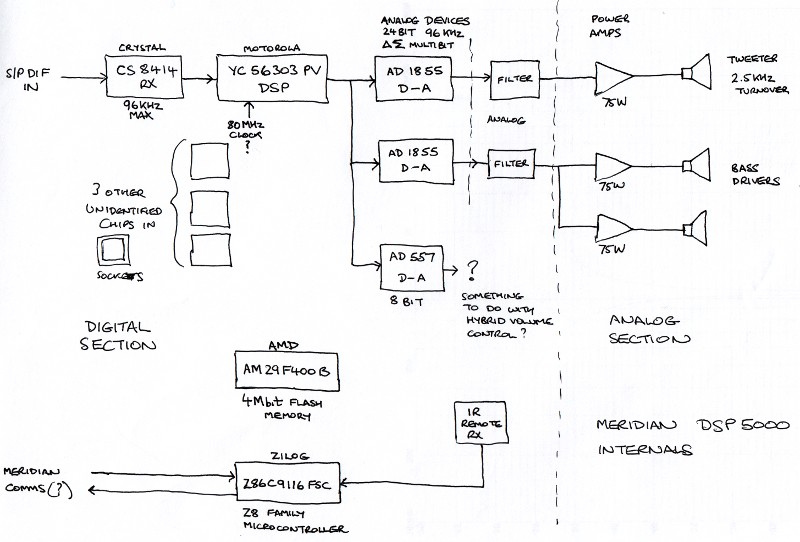 Detailed information on the innards of DSP-5000's isn't easy to find, so this may be of
interest. It is possible to plug a terminal (emulator) in to the DSP-5000s and send them
commands (via a 9 pin serial cable - this is a bit before USB!). Information on those
commands can be found here.
Detailed information on the innards of DSP-5000's isn't easy to find, so this may be of
interest. It is possible to plug a terminal (emulator) in to the DSP-5000s and send them
commands (via a 9 pin serial cable - this is a bit before USB!). Information on those
commands can be found here.
By 2003, the configuration had changed a little bit to that shown below.
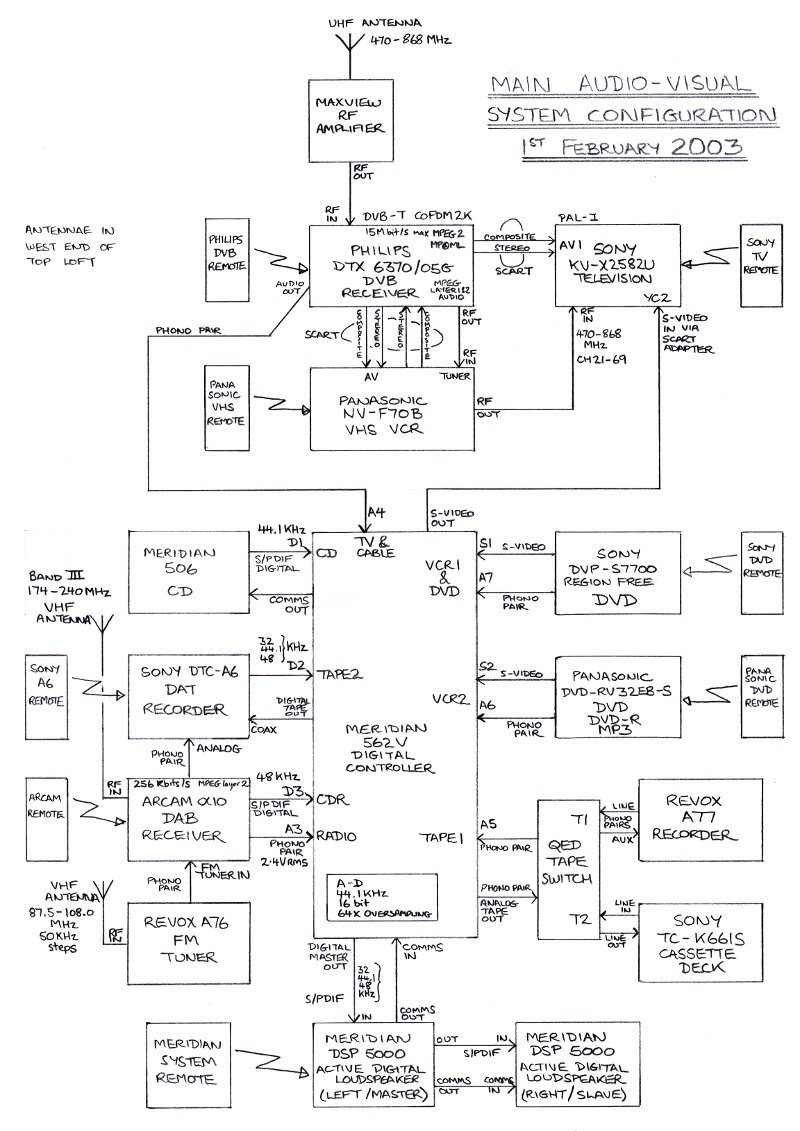
By 2000, I had replaced the Audiolab 8000T with an Arcam Alpha 10 DAB tuner. I finally sold
the 8000T on E-bay in 2013. This DAB tuner is still my main radio source and gives excellent
results with 192kbit/sec streams (which means only Radio 3 on a good day in the U.K. -- below
160kbit/sec, DAB is unquestionably worse than FM and all U.K. stations apart from Radio 3 fall
in to that bit rate category, unfortunately). I have recently been experimenting with Internet
"radio", however, and I think that high bit rate streams (e.g. 320kbit/sec) are audibly better
than the best DAB broadcasts available in the U.K. I suppose they should be better -- but I'm
surprised that I believe I can hear the difference.
By 2003, video is firmly based around DVD replay with the ability to replay DVD-R and MP3 files
stored on CD-R or DVD-R. The television is still CRT - plasma displays were still many thousands
of pounds. That didn't really change until 2008 or so, when prices started to decline very steeply.
Time shift recording was still done on VHS (with a nice Panasonic machine I bought back in
1991 to replace the stolen JVC). Broadcast TV had already moved to digital though ... DVB-T
(Digital Video Broadcasting -- Terrestrial), also known as Freeview, arrived around 1998 (for me)
with a first generation Philips "set top box". Analog services were finally turned off across the U.K.
in 2012, allowing DVB-T to use higher powers with better coverage and allowing most major stations to
offer HD versions of their output.
Note also the ReVox A76 tuner.
I had started to get interested in "vintage" Studer/ReVox equipment to partner the A77.
A dangerous trend ...
One last thing I did in 2003 was to try to measure my hearing response against frequency.
I basically tried to detect the lowest amplitude signal I could hear at a set of spot frequencies.
This was a very amateurish affair, but the results are sort of what might be expected for
a moderate loudness from looking at Fletcher-Munson curves (and the like). I basically couldn't
hear anything above about 16kHz or below about 30Hz.
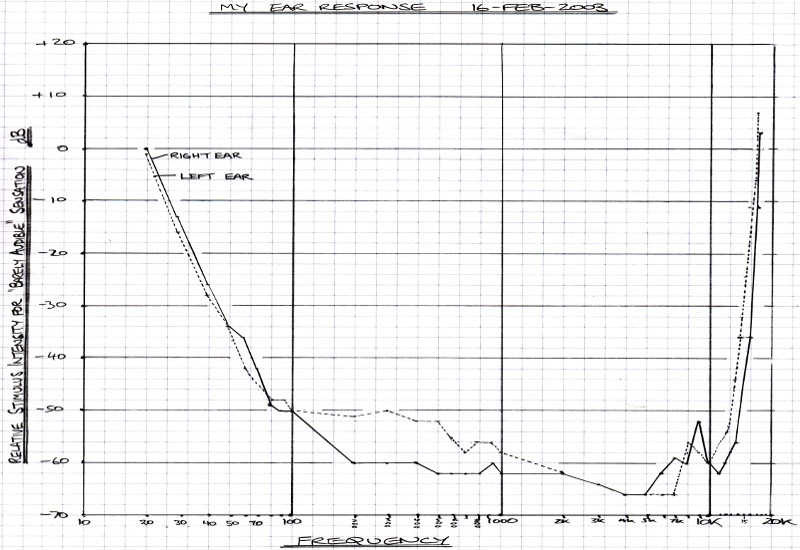 I was 44 years old at the time. Things will only have got worse since then ...
I was 44 years old at the time. Things will only have got worse since then ...
Go to top ...
2004
Meridian introduced a replacement for the 500 series components -- the G series -- in late
2003 (although they were scarce as hen's teeth until early 2004). I decided to replace the
562V and 506 with a G91DH. This combined the "digital pre-amp" capabilities of the 562V
(but upgraded to 96kHz/24bit capability) with a DVD/DVD-A player and an FM tuner in one
compact package. This was another expensive purchase (£3,500). I haven't spent such sums on
any audio component since, and it is very unlikely I will be doing so ever again! I recouped £800 from
selling the 562V and 506 though.
Now, here is a confession. I always felt there was something not quite right with the 500 series
plus DSP-5000 combination. This was nothing obvious ... but CDs I was very happy with when replayed
on my old "budget system" sounded harsh to me -- to the point of setting my teeth on edge in a couple
of cases. Perhaps the new system merely revealed defects the old one couldn't resolve?
However ... this problem went away when the G91 arrived. I have no rational explanation for this.
Put it down to psychological factors if you wish. The only objective improvement was that
16bit/48kHz (max) processing was replaced with 24bit/96kHz processing ... but ... the
CDs were still 16bit/44.1kHz - the source material had not magically been improved.
I don't know what to make of this, but if I am being honest, I have to admit that something
seemed to improve significantly. The system as a whole finally worked as well as I had originally
hoped it would. As a firm "objectivist" I find this a little unsettling.
The diagram below shows the 2004 setup:
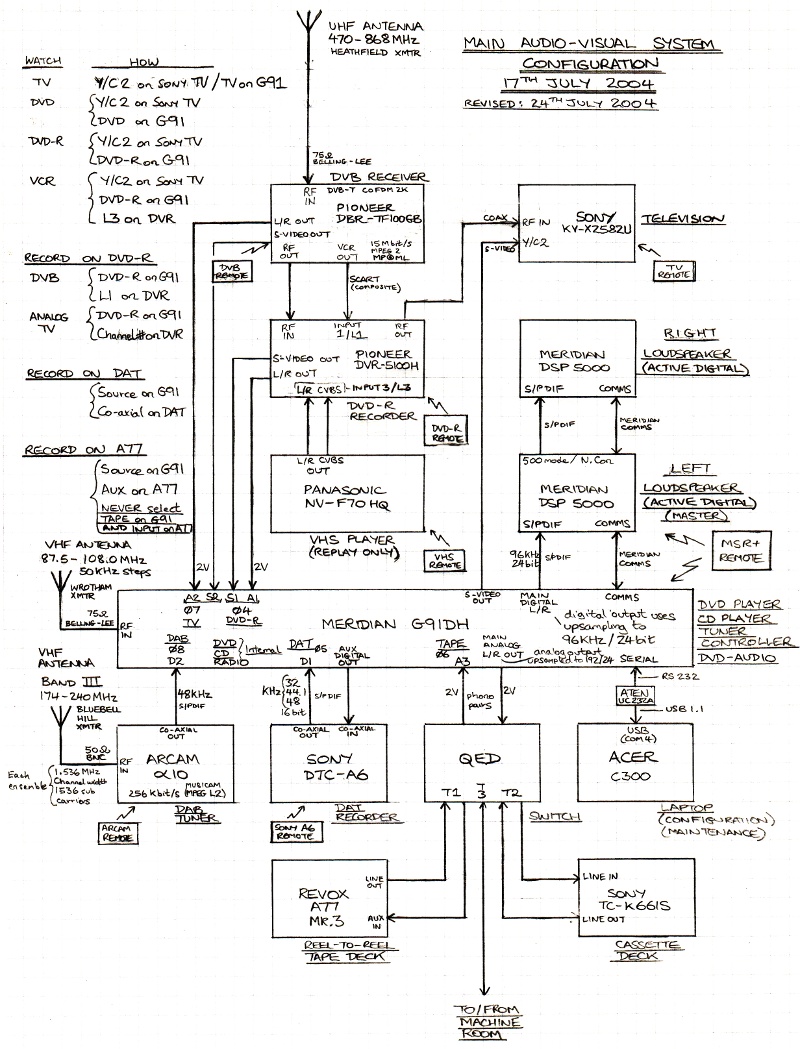 Video was now time shifted with a hard disk based "PVR" from Pioneer and a newer "set top box"
(also from Pioneer) speeded up channel changes, if nothing else. This was all standard definition
PAL, of course (720x576 interlaced).
Video was now time shifted with a hard disk based "PVR" from Pioneer and a newer "set top box"
(also from Pioneer) speeded up channel changes, if nothing else. This was all standard definition
PAL, of course (720x576 interlaced).
I also tried some initial experiments with computer based audio at this time. Frankly, this was
a pain in the neck in practice. I was using a Terratec sound card in a Linux machine located in
my work room (one of the two bedrooms!) and controlling it from the living room
(over wired Ethernet with a tiny Toshiba Libretto computer) was not exactly
straightforward. I ran long audio and Cat 5 Ethernet cables down from the bedroom to the living room.
It sort of
worked, but all in all, it was a system not even its mother (or, in this case, father) could love.
It got very limited use -- just a few experiments with ripping CDs and a few recordings direct
to disk. Some of the setup is shown in the diagram below:
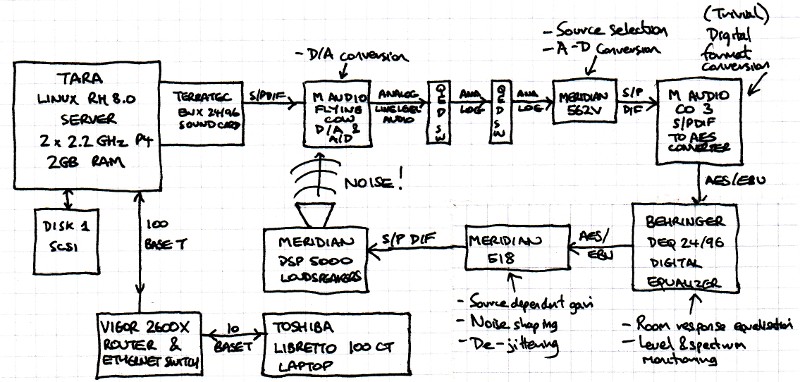
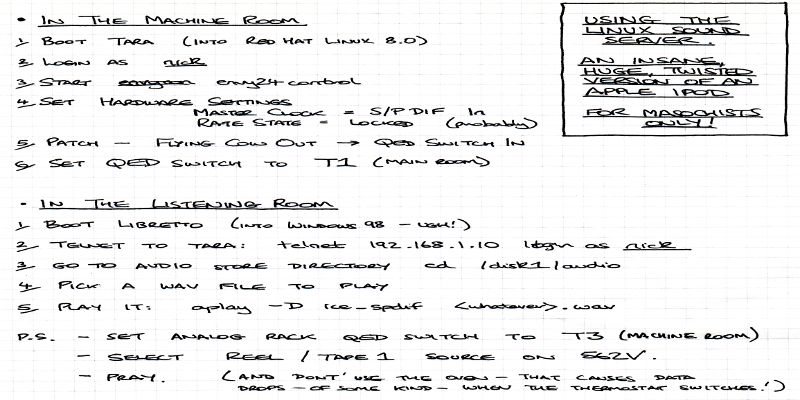 At this time, computers were fine for listening to CDs through headphones
while working (and had been since the late 1980's - using CD-ROM drives with a separate
analog audio path), but they weren't quite ready to serve as digital music sources for
high quality audio systems. It was very clear, though, that it wouldn't be long before
they were.
At this time, computers were fine for listening to CDs through headphones
while working (and had been since the late 1980's - using CD-ROM drives with a separate
analog audio path), but they weren't quite ready to serve as digital music sources for
high quality audio systems. It was very clear, though, that it wouldn't be long before
they were.
Another small experiment at this time was with room acoustics: what was the listening room
doing to the sound from the loudspeakers and could improvements be made with an equalizer?
Well, I did a few measurements using
this
equipment and ETF 4.0 software (from this company, although
they seem to have a somewhat different product now). I also bought a Behringer DEQ-2496 digital
equalizer with the aim of perhaps sorting out measured problems. But I didn't actually get
very far. I found the measurements more confusing than useful and the DEQ-2496 ended up sitting
on a shelf for the next 5 years or so.
Go to top ...
2007 - ReVox A7X Collection and the Studer A-812
There were a few significant developments in 2007.
First, I finally got around to fully sorting out my ReVox A77 to get
it working the way it always should have. The gory details can be found
here.
ReVox A78 Amplifier renovation
Secondly, I found a ReVox A78 amplifier on E-Bay (for £40). This completed the set of A7x components, all
with Mark III cosmetic details. The A78 needed quite a lot of work, which I got around to in 2011. This
involved replacing almost all the polarized capacitors, most of the internal trimmer potentiometers,
repairing a broken track on one of the power amplifier boards, replacing the thermal bias compensation diodes
and setting the correct quiescent current again. Everything that wasn't changed was at least cleaned. This
fixed all the issues for a cost of less than £50, although it did take quite a long time to do. An excellent
account of such a renovation can be found on the "Studer ReVox Analogfan" site at
this page (this is a terrific
site, by the way). Below are some photos I took during my version of this.
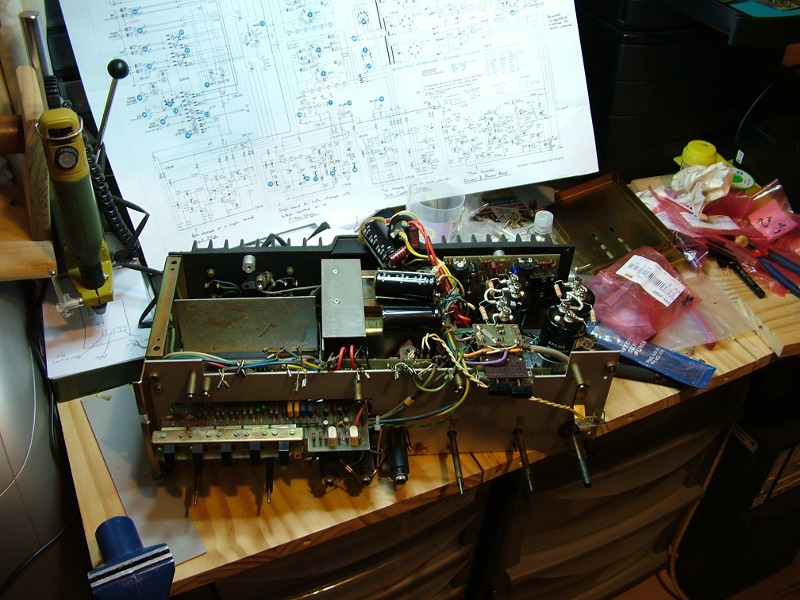 In many pieces, with the new power amplifier power supply smoothing capacitors
in place and the old ones dangling on top.
In many pieces, with the new power amplifier power supply smoothing capacitors
in place and the old ones dangling on top.
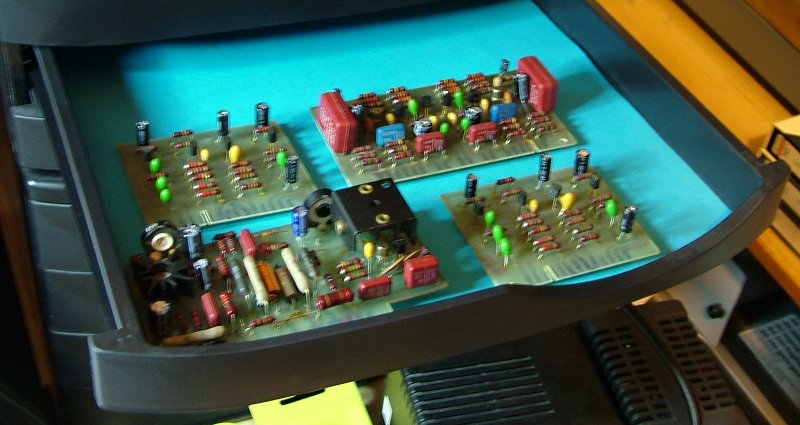 Some of the plug-in cards after recapping awaiting re-installation.
Some of the plug-in cards after recapping awaiting re-installation.
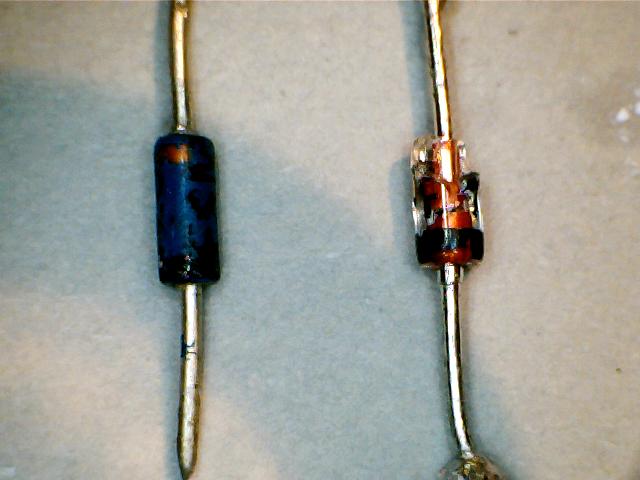 Old and new thermal compensation diodes. Yes - the new one is slightly fatter! They
are supposedly exactly the same types, of course.
Old and new thermal compensation diodes. Yes - the new one is slightly fatter! They
are supposedly exactly the same types, of course.
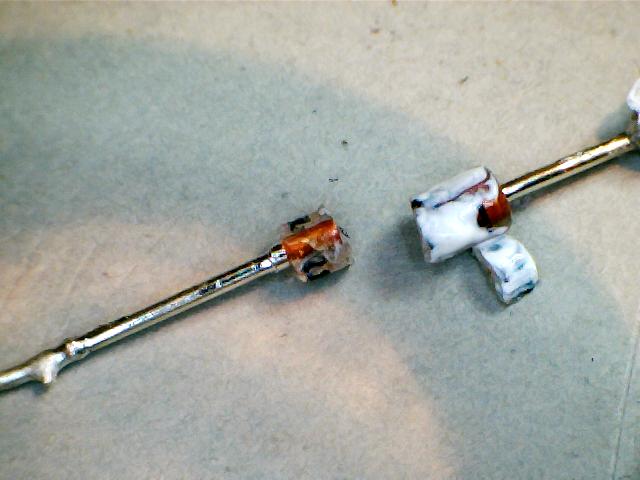 The new diode breaks when fully installed ... Yuck! Careful widening of the mounting
aperture on the heatsink was required. Several new diodes died getting this right!
The new diode breaks when fully installed ... Yuck! Careful widening of the mounting
aperture on the heatsink was required. Several new diodes died getting this right!
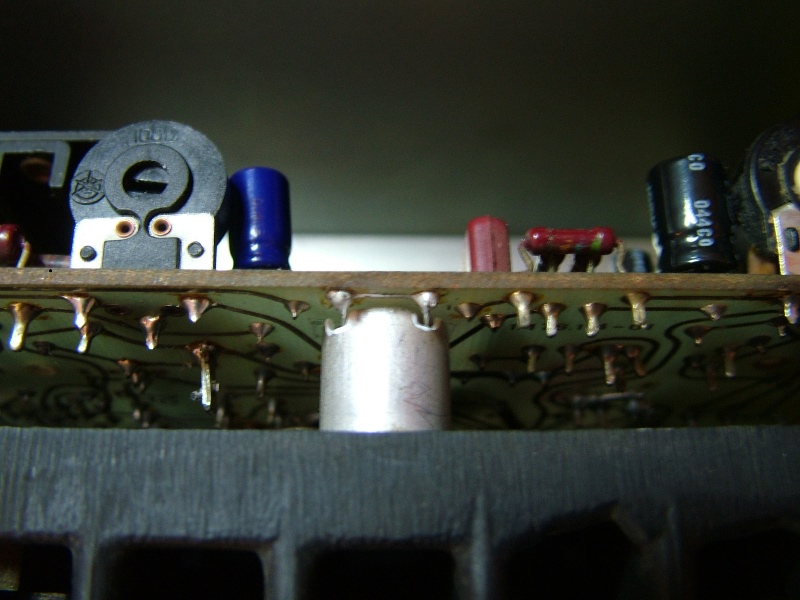 As you can see, it is a tight fit! It has to be, of course.
As you can see, it is a tight fit! It has to be, of course.
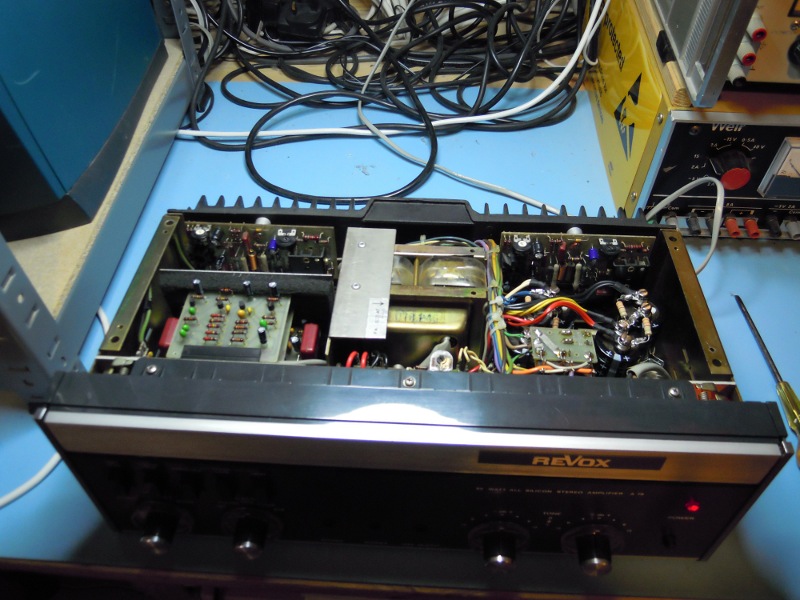 Back together again and being tested.
Back together again and being tested.
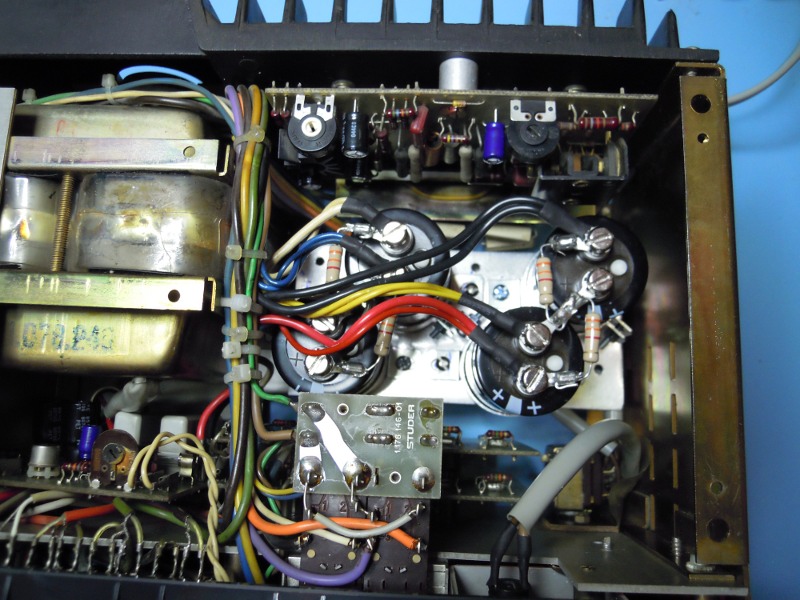 The new power amplifier power supply smoothing capacitors at work.
The new power amplifier power supply smoothing capacitors at work.
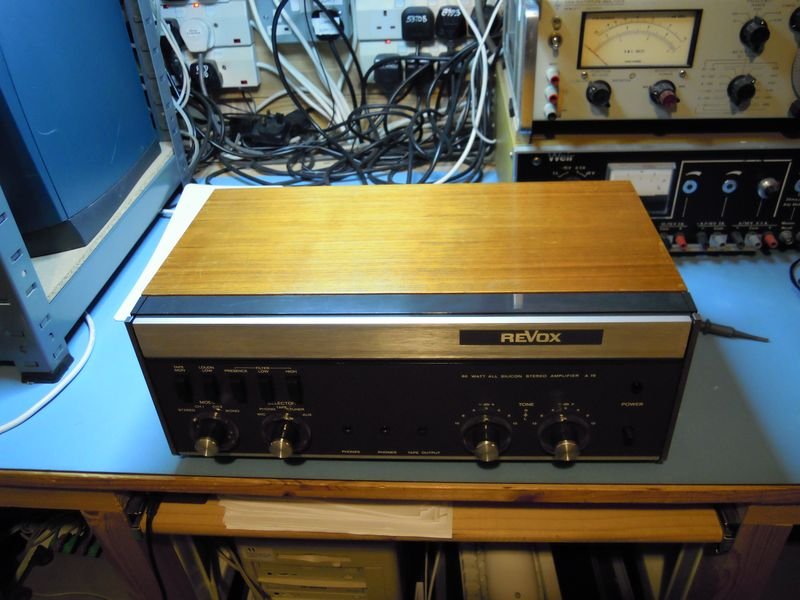 With the case back on, ready to go back in service.
With the case back on, ready to go back in service.
Go to top ...
Studer A-812
Finally, because "renovating" the ReVox devices was so satisfying and worthwhile, I started to look for
"professional" Studer machines on E-Bay. Studer was the parent company of ReVox, founded in
Switzerland by Willi Studer, who is something of a hero of mine. Beginning life as an orphan,
he became a major figure in the development of audio technology in the post World War 2 years --
especially of tape recorders. Everything his companies made oozed quality and engineering excellence.
I had a pretty good idea of the range of machines Studer had
made over the years and the A-810 was what I really wanted. Unfortunately, the machines that came up
fell in to two categories:
- Too expensive (>£2000 for really nice examples -- although there were very few of those).
- In an absolutely abysmal condition. It looked like some of them had spent some time underwater
judging by the amount of corrosion on them! Almost all of these were "ex-BBC", covered in razor
cut marks (from tape editing) and generally in a lousy state.
However, eventually I saw an auction for an A-812 that looked in remarkably good condition from the
photographs. The starting bid was £375 and the guy selling it lived in Kent and could deliver it! This
I could not resist. Amazingly, no one else bid on this and I won it for the starting bid price!
The A-812 is almost a full size studio machine. It sits (sort of) in between the "compact" A-810
and the "flagship" A-820. The latter is one of the best three or four types of tape machine ever built.
The A-812
is (thankfully) rather smaller (although still quite big enough and very heavy). It (literally) uses a
mixture of A-810 and A-820 technology with some unique features of its own (e.g. the PWM drive for the
reel motors). The A-810, A-812, A-816 and A-820 are members of the final generation of analog tape machines
in which both the tape transport and audio circuitry are controlled by software in microprocessors.
When it arrived, I must admit to thinking I had bitten off far more than I could chew. It came with
its standard "console" stand, although my version didn't have the VU metering bridge. Although much cleaner
and less marked than most "ex-BBC" machines, there was rust on the stand and the whole thing smelt of
cat pee! I feared the worst.
The first thing I did was have a very good look everywhere that could be accessed and I cleaned every
thing I could get at. The machine itself was actually in very good condition as far as I could tell,
in spite of the state of the stand that held it. I tried applying power and running some tape through it,
and everything seemed to work. Maybe not a disastrous purchase after all.
To make it domestically acceptable, the stand had to go. I built a wooden box for it as a replacement,
on large castor wheels so it could be moved easily. This box had to be rather substantial as the machine
weighed upwards of 75kg! (Even more than me -- just.)
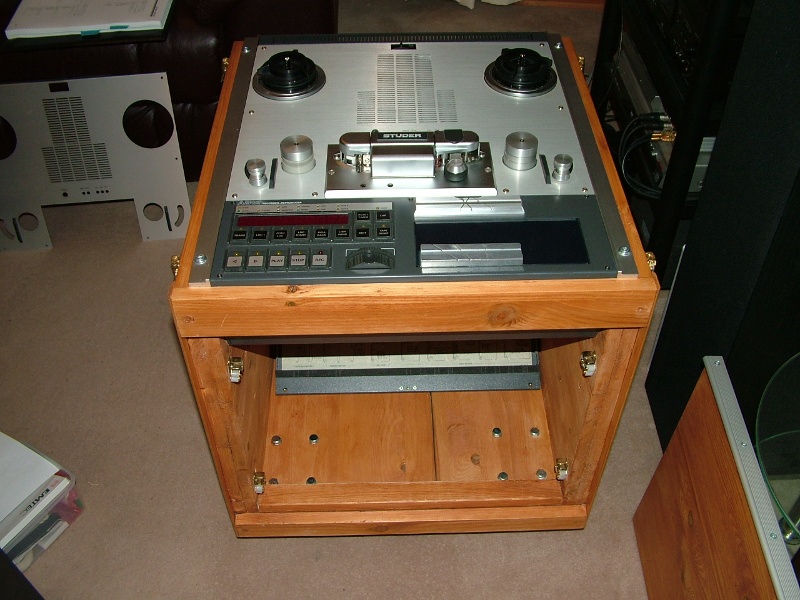
The next problem was connecting it to anything I owned. Being intended for use in professional studios,
it had balanced inputs and outputs. These can be wired directly to unbalanced RCA phono plugs, but for
balanced outputs, you need to know if the balanced output is electronic or transformer based to
know how to do this (my A-812 uses transformers -- although this depends on the line driver
card type installed). The best guide to this is on the Rane Audio Products
site here.
Metering the levels going in and out of the A-812 was another matter though. Eventually, I realized
that the Behringer DEQ-2496 (which has balanced inputs and outputs) could monitor the levels being
recorded and could even adjust them (in a very unwieldy fashion). So I got it down off the shelf
where it had been sitting since 2004. Later, in 2009, I built an active balanced to unbalanced (and
vice versa) converter using THAT Corporation 1646 line drivers and 1246 line receivers. This was
a stop gap while working on the "ultimate solution" to interfacing with the A-812. More on this below.
Sketches of the circuit and PCB layout for this stop gap device can be found
here (warts and all).
The A-812 is quite a beast. It is an extremely complex machine with a network of microprocessors
controlling all the tape transport and audio functions. The service manual runs to some 1000 pages.
It relies entirely on firmware, of course, so one thing I did was back up the EPROMs in case they
one day go bad.
Almost all the audio circuitry and the main controlling microprocessor is implemented
on plug-in cards in a card cage under the machine.
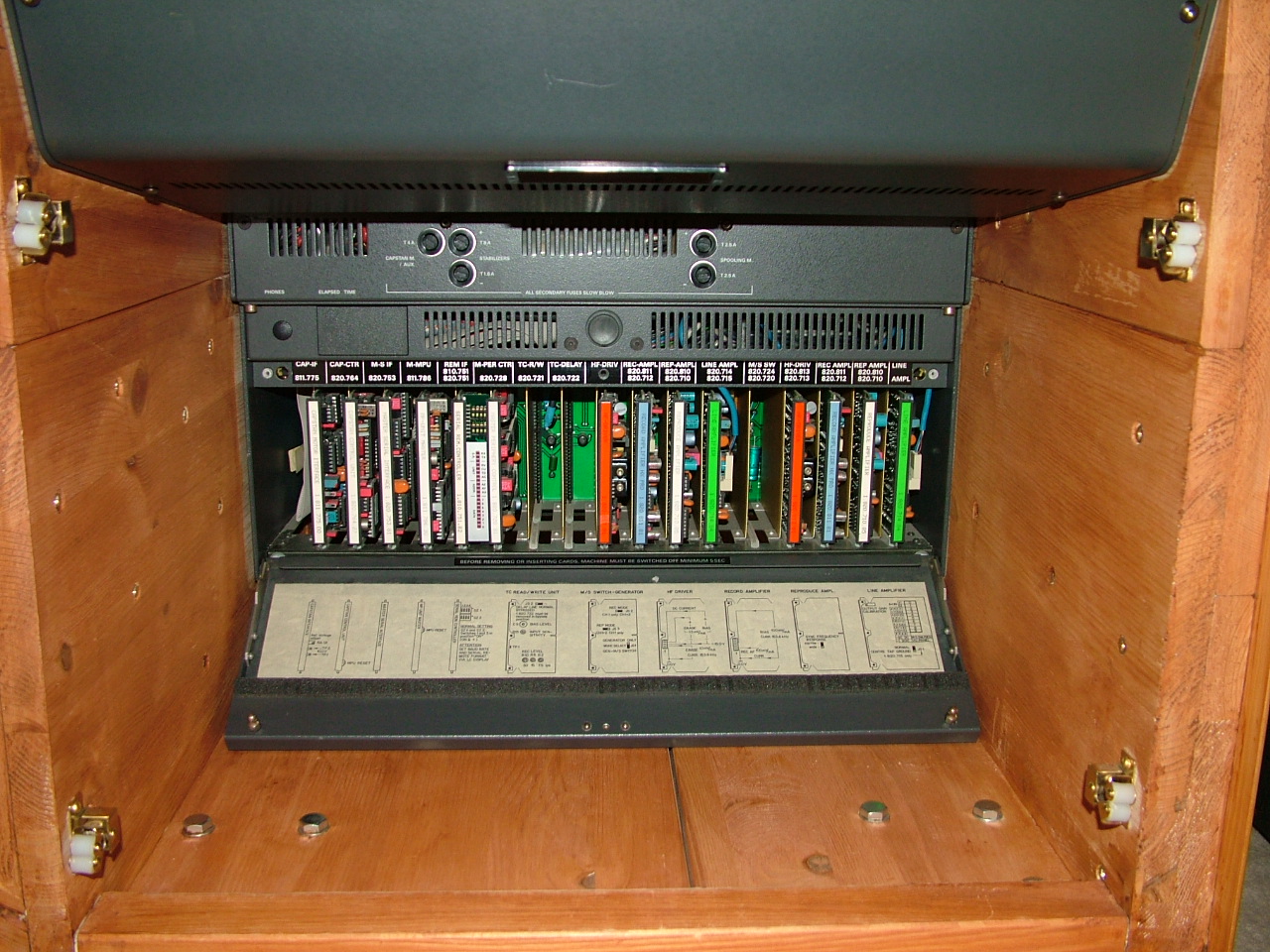
The tape transport controller cards live in a tray under the tape transport itself.
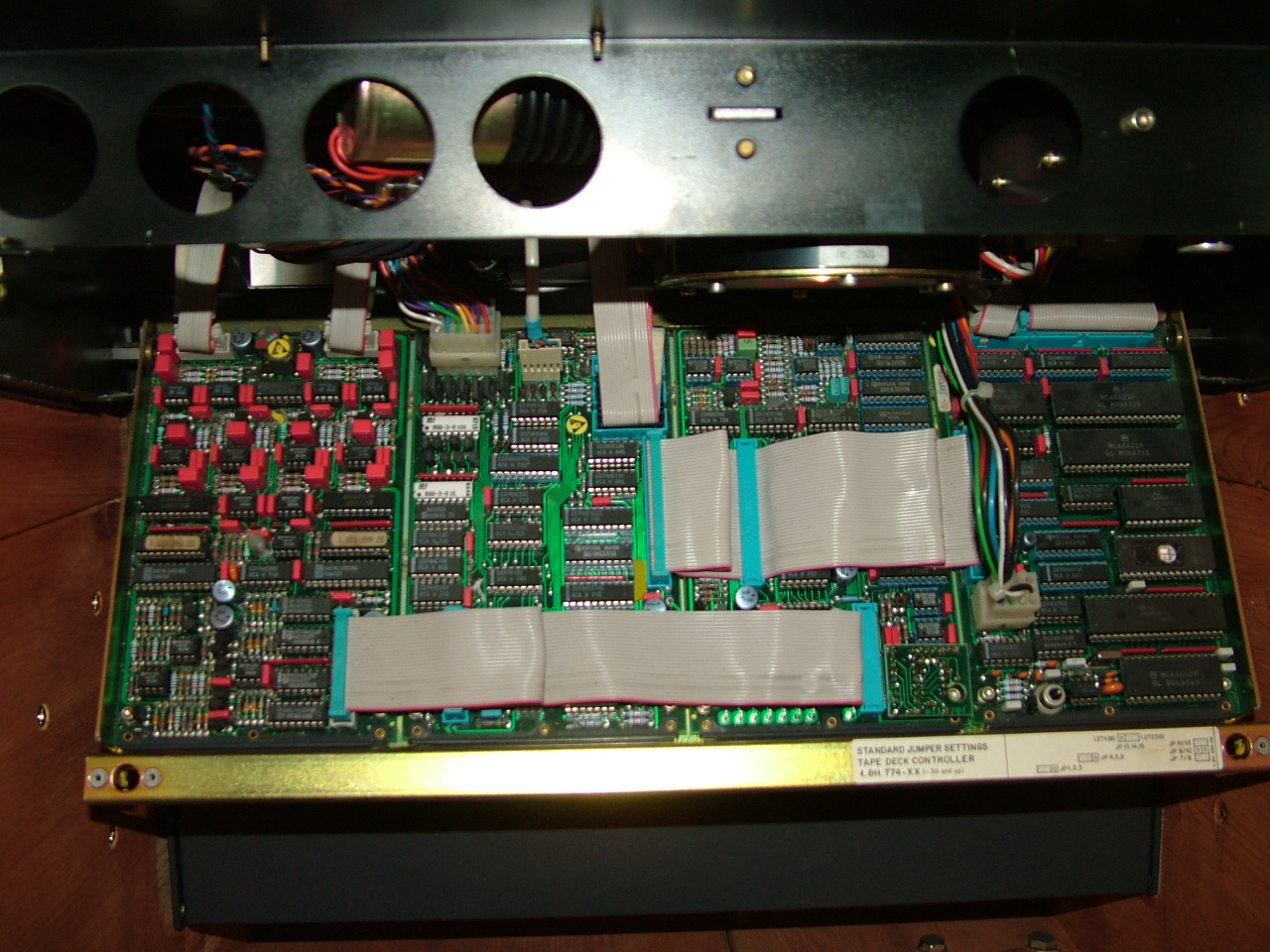
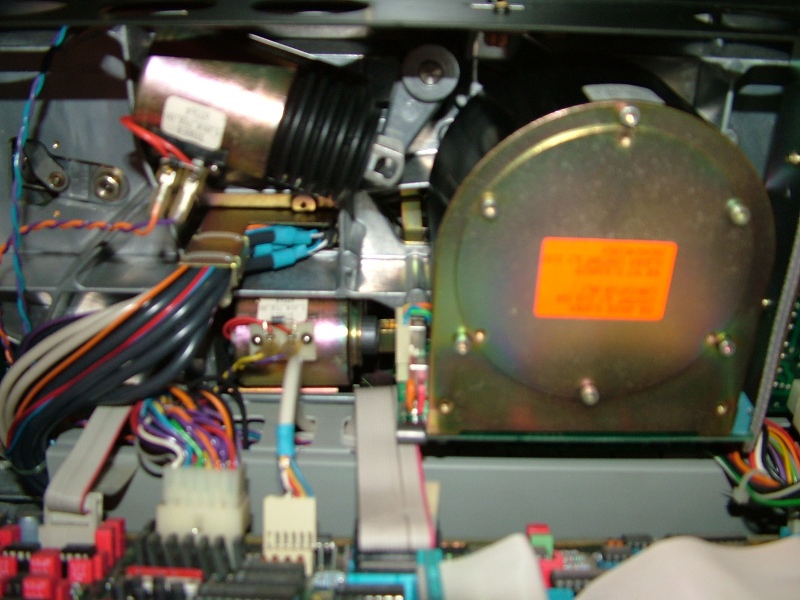
The switch mode power supply and the reel motor amplifiers are mounted on a fold out rear panel.
The reel motors are entirely firmware controlled with a pulse width modulation scheme controlling
their speed and torque. The reel motor amplifiers drive the motors by amplifying the low level
signals from the controller. It is all very clever, but somewhat scarily complicated.
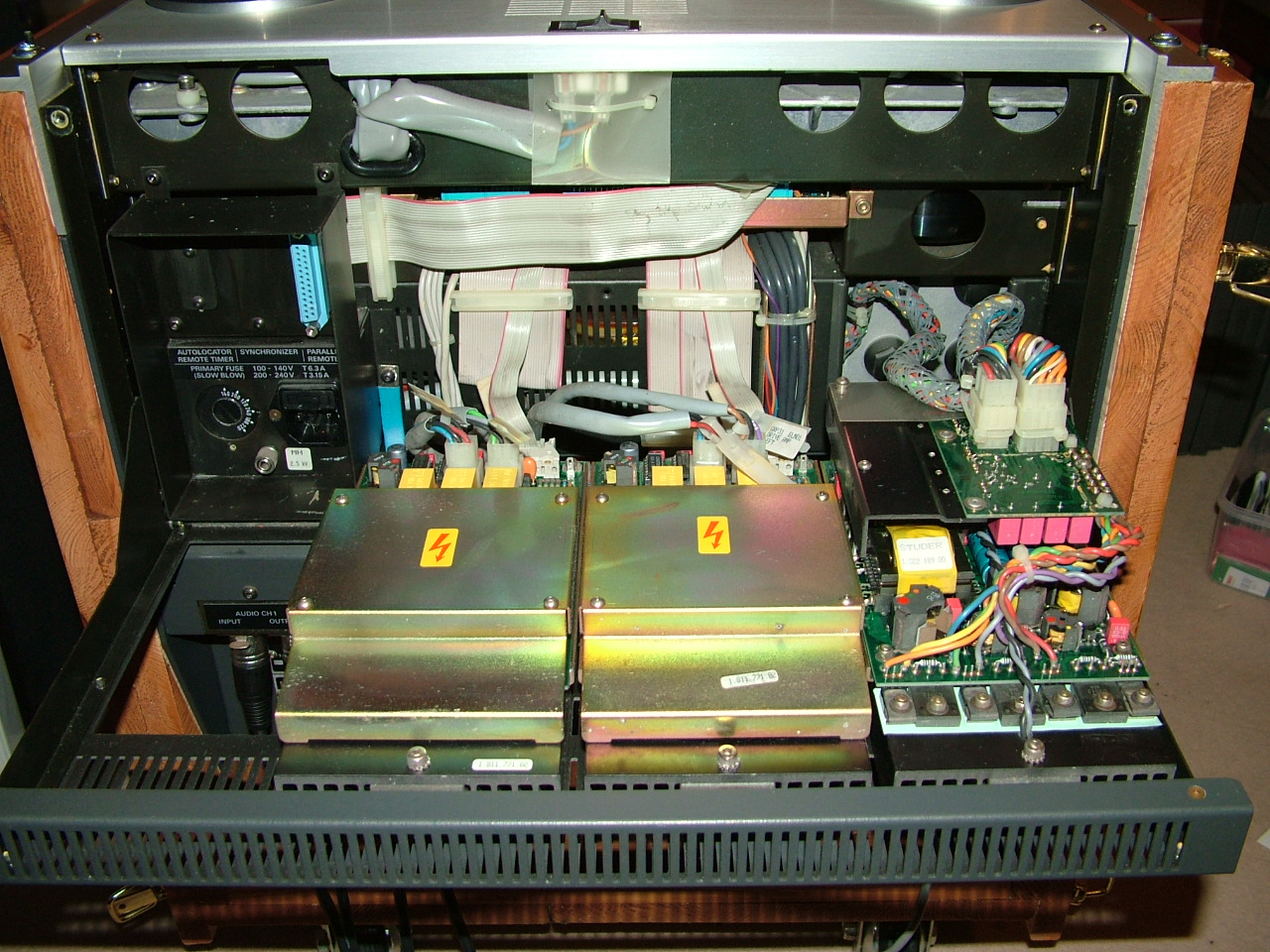
Many of the control panel keys are "soft" and can be assigned the functions that are
important to you, while options that you don't need to change can be setup once and not
assigned to a key. The keys under the lift up panel are for less used functions, for
programming the other keys and for accessing the A-812's control menu tree. It is through this
menu that alignment and calibration for a tape type is done. The appropriate parameters for
two different tape types at four tape speeds can be stored.
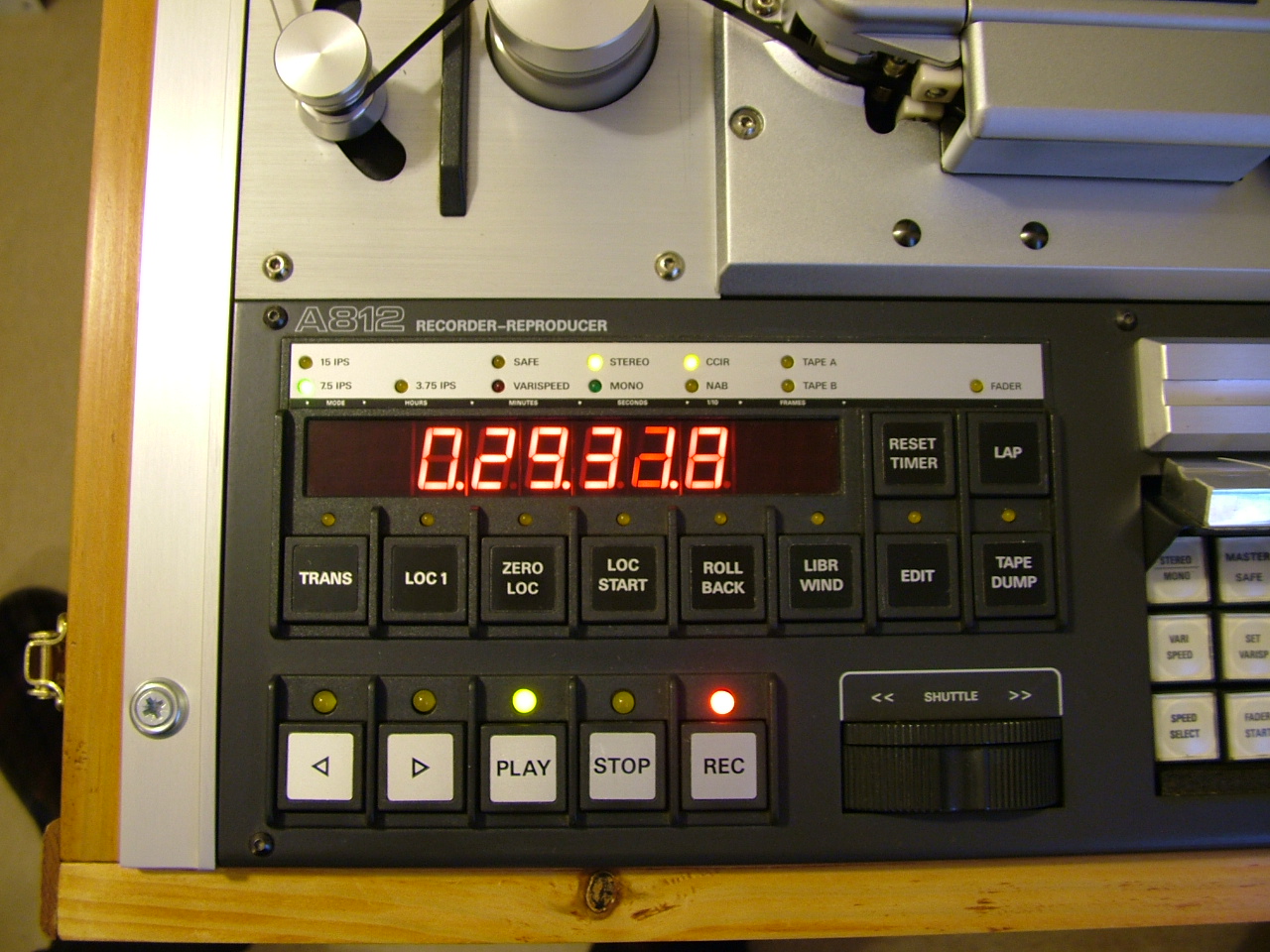
Here are a few close ups of the tape transport and heads.
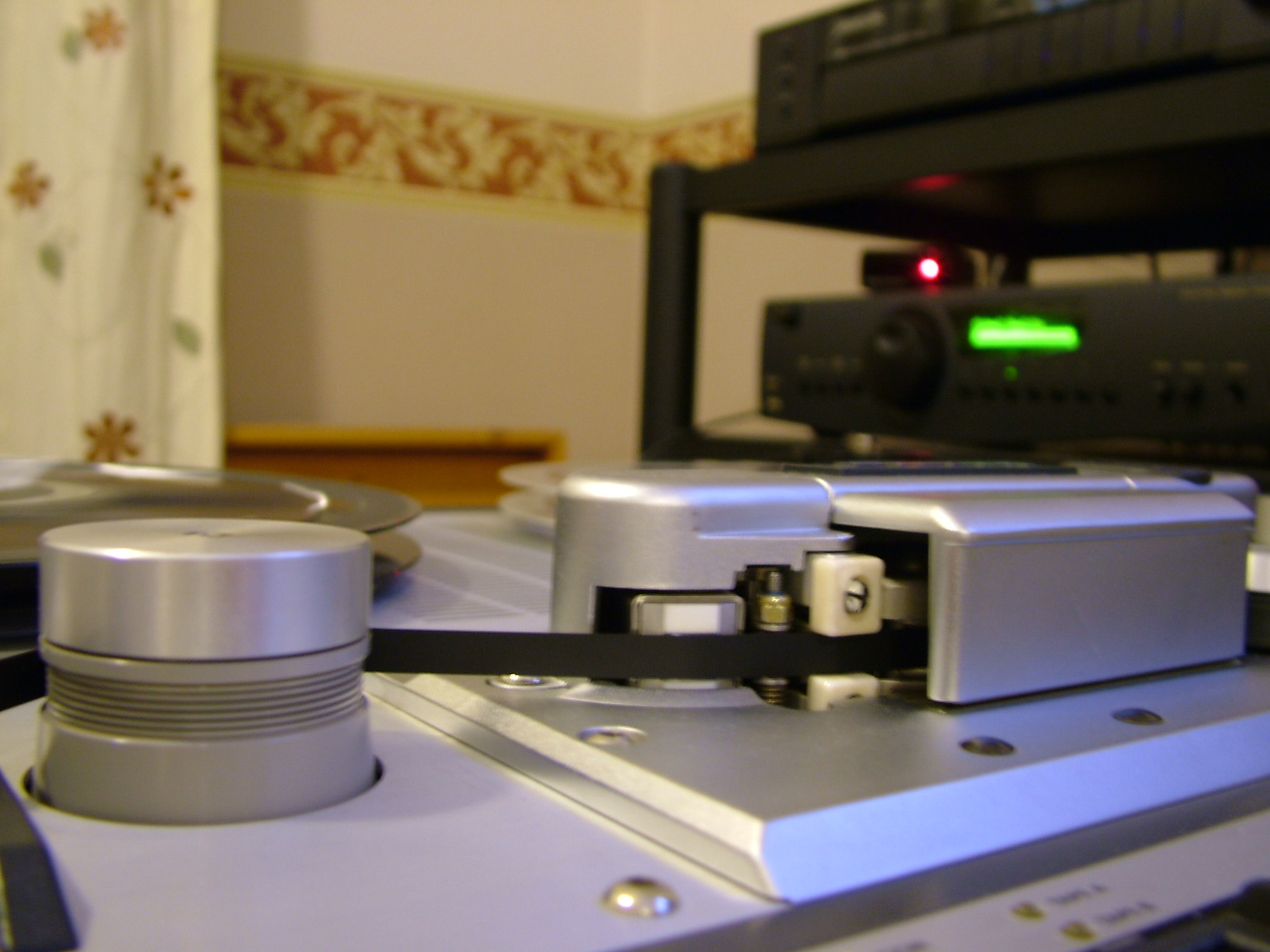
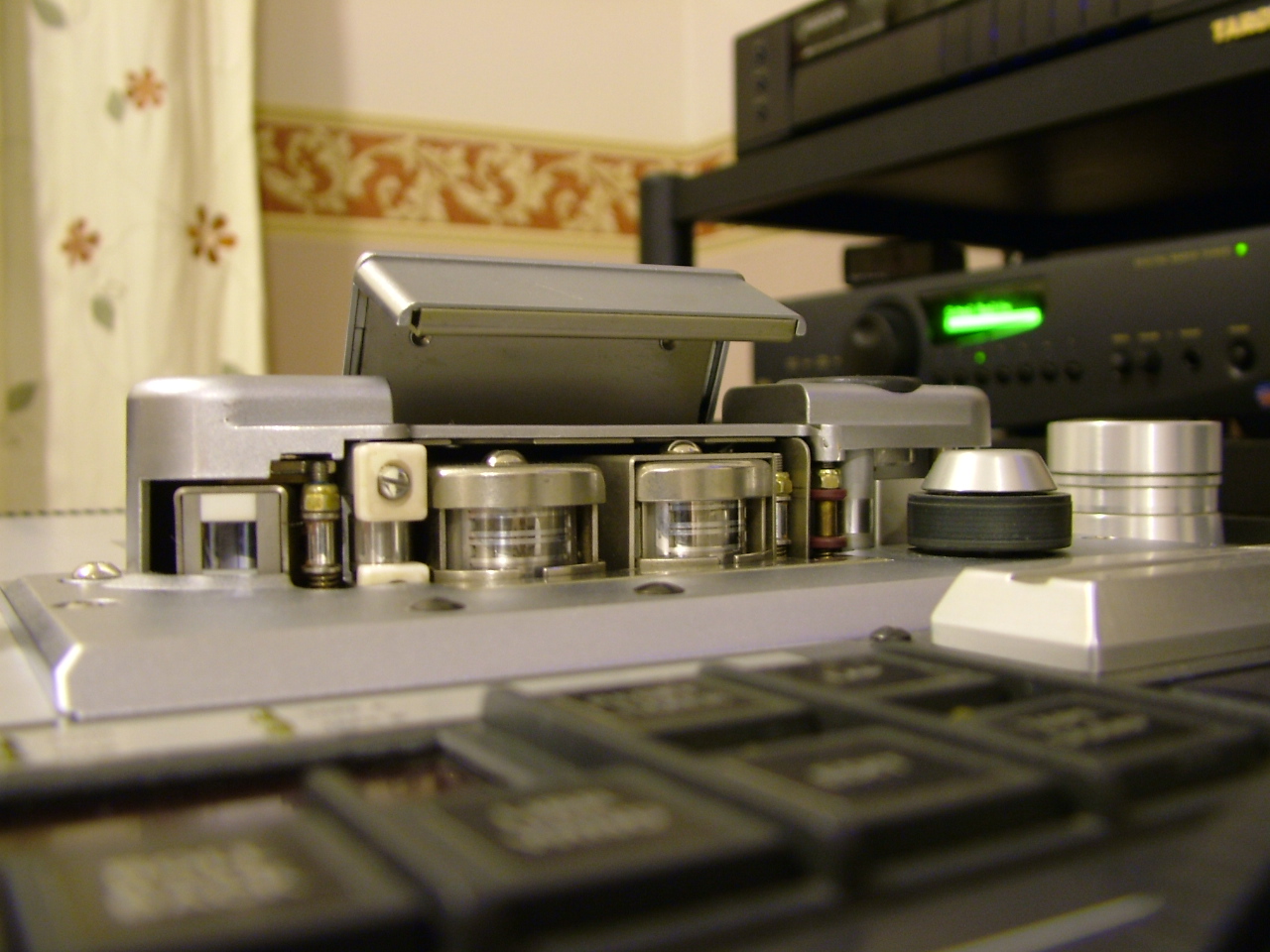
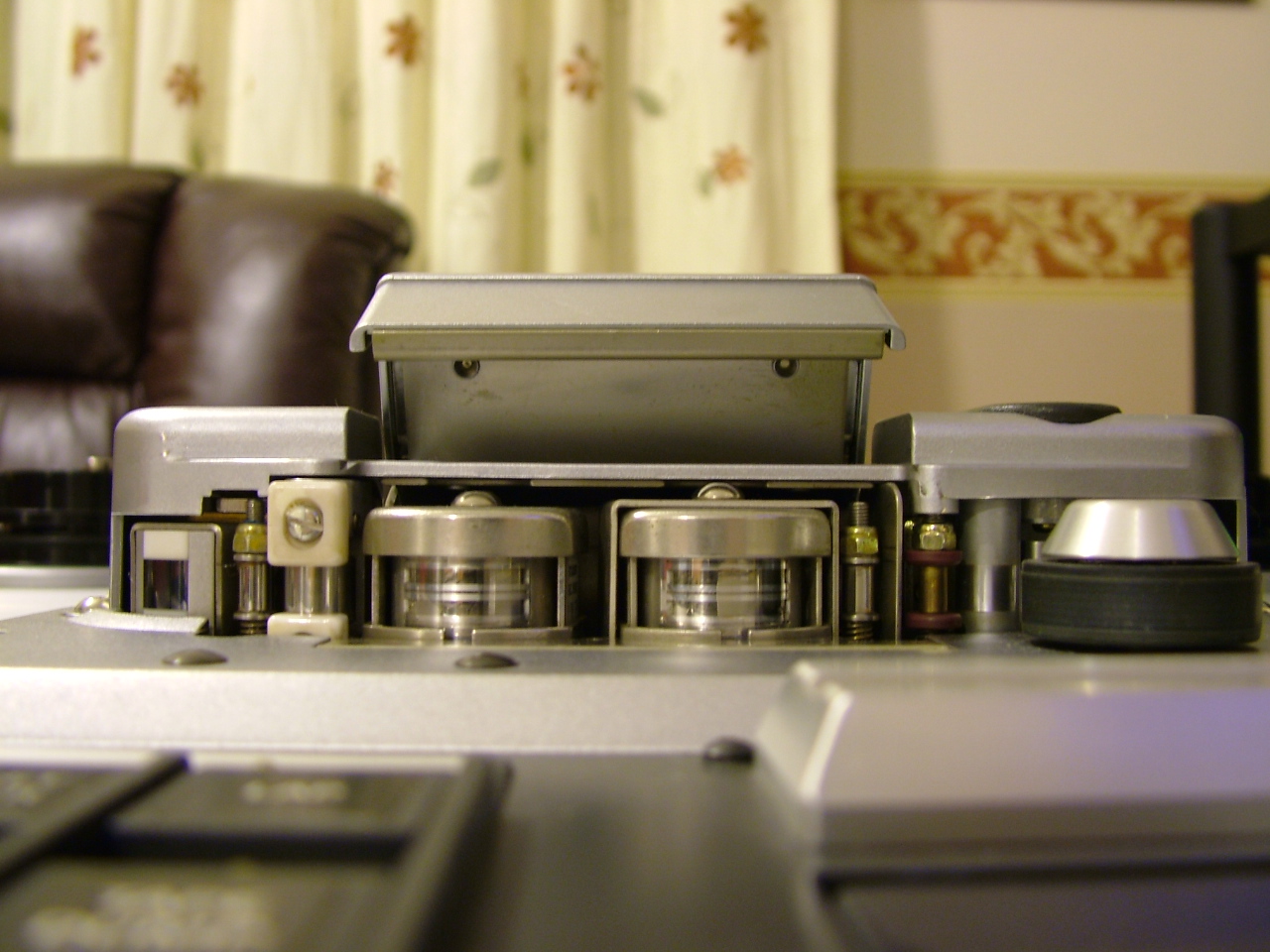
The connections to the A-812 are all at the rear (of course). The audio connections are on the lower
left. Above those are the mains inlet and parallel remote connector. This is plugged in to an infrared
remote control adapter on my machine, made by R2R Remotes (a
very small British company). At the lower right is an interface to a BBC RD4/17 fader which the machine
came with. I bypassed this, but before doing that, I traced a circuit diagram for it. If anyone is
interested, here
is the information I managed to get from that exercise. This device also attached to
the parallel remote, so fading up started the A-812 playing. The right most plug is an RS-232 connector
(but with very non-standard pin-outs!) through which just about everything can be controlled
from a computer. This works well through a USB to RS-232 adapter.
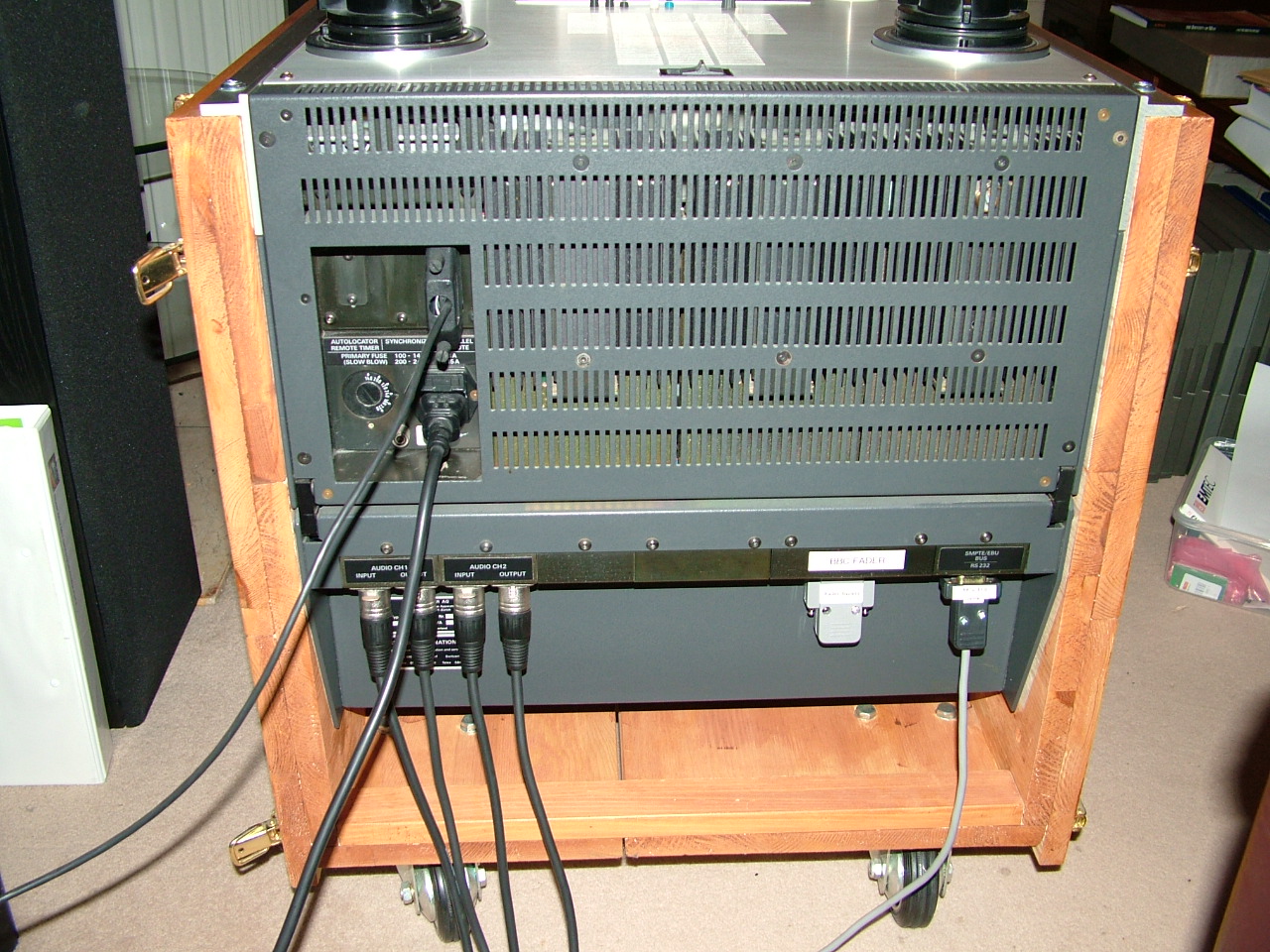
Well, that is a lot of machinery for £375, isn't it? It sounds wonderful and the tape transport is
a joy to watch. It spools tape at a fixed maximum (selectable) speed and the tape wind is near perfect.
It knows where it is in the tape and when rewinding it slows to a "safe speed" before it reaches the end
of the tape. An extraordinary thing ... but so much more complicated than the A77!
Why did the final generation of analog tape machines grow so complex? There are a couple of
reasons:
- The need to be synchronized to video using SMPTE timecode. My machine doesn't have this facility
but other A-812s (810s and 820s) do. Chasing timecode requires a very sophisticated digitally
controlled transport.
- Operating convenience. You can align the machine entirely from the front panel by pressing
keys. Once aligned, you can store and recall entire parameter sets with the press of a key
(tape type and/or tape speed).
- Automation. Just about everything on the A-812 can be controlled by computer via an RS-232 link.
For very tight, time critical control, a parallel remote connector gives access
to low level functions that can be used by special purpose external equipment.
- Squeezing the last drop of potential performance from the basic analog tape medium.
Today, there is no real reason to use analog tape. It is inconvenient, expensive and inferior in
every way to digital recording, according to every objective measurement. I use it because the
technology fascinates me (and always has). I have had a fairly extensive go at understanding how
AC bias analog recording actually works, as detailed in this page.
It is a far from simple process.
The subjective quality of analog tape recording is also remarkably good -- much better than you would
guess from the objective measurements. The defects are audible if you listen for them, but they are
negligible with a good machine at 15 ips. I just like it!
The arrival of the A-812 and the need to interface it properly to the rest of my gear with
proper level monitoring and control prompted me to enter a new phase of DIY audio ...
Go to top ...
2008 - 2013 - The Recorder-Reproducer Interface
The ultimate solution to the problem of monitoring and controlling the signal levels going to and
from the A-812 was a special purpose pre-amplifier with metering and designed with calibrated levels
in mind. Now, this ended up being completely "over the top"! The simple answer to this problem (and
the balanced to unbalanced conversion issues) is to buy a mixer. You can get good ones for a few hundred
pounds -- see any of dozens of advertisers in Sound-on-Sound magazine and similar publications.
However, I wanted to "do it myself". Just what I wanted to do included rather more than just getting
a decent solution to my immediate "interfacing" problem. I wanted to learn how to use modern PCB design
tools (specifically KiCAD), use them to make my own printed circuit boards (etching and drilling
them at home), and
to do all parts of the design and assembly of this device myself (including the metalwork -- albeit starting
with a standard case). In short, it was intended to be mostly a learning exercise, but with a useful
(to me) end product.
After much sketching of diagrams, reading and thinking about what I ideally wanted, the block diagram
below emerged.
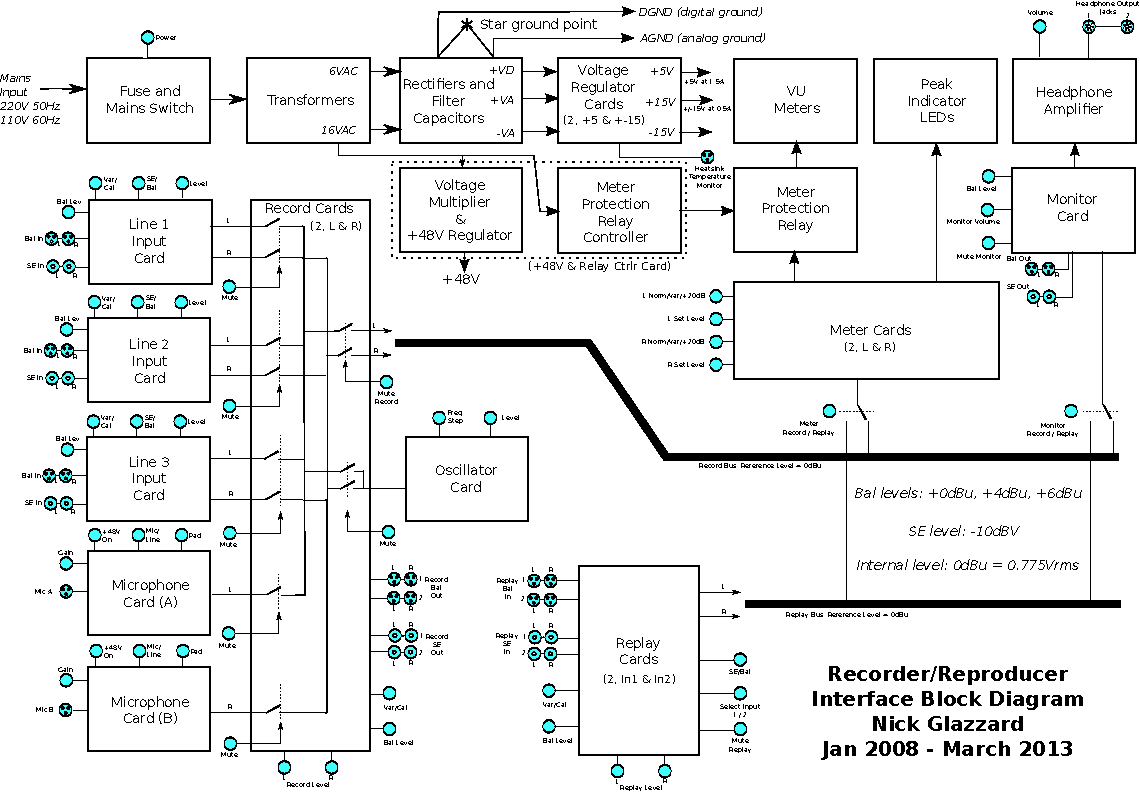 The key features are:
The key features are:
- VU meter and true peak metering (at critical levels of +6, +12 and +18dBVU).
Switchable +20dB and variable gain for assistance in lining up tape machines.
- Three line inputs, each of which can be switched between balanced and unbalanced inputs.
The balanced inputs can individually be set for +6dBu, +4dBu or 0dBu corresponding to the
internal reference level and hence 0dBVU. (This is quite unnecessary overkill!). Unbalanced
(SE) level of -10dBV corresponds to reference level.
- Switchable calibrated or variable gain options for each input.
- Two high quality microphone preamplifiers with standard +48V phantom power
optionally available.
- Low distortion sine wave test oscillator switchable to standard tape line up
frequencies and 0dB or -20dB attenuation.
- The ability to send any combination of these outputs to the "record bus".
- Two independently driven "record" outputs for simultaneous recording by two separate
devices (e.g. A-812 and computer). Simultaneous balanced and unbalanced outputs available
for both devices.
- Two independent "replay" inputs, each with balanced and unbalanced inputs. Balanced
input reference level switchable between +6dBu, +4dBu and 0dBu. Switchable calibrated
or variable gain options.
- Monitor output (to drive a power amplifier or interface with the rest of an audio system)
with simultaneous balanced and unbalanced outputs (balanced output levels switchable).
- Metering and monitoring can be switched independently between the "record bus" and the
"replay bus".
- Good quality headphone amplifier with independent volume control.
- All signal switching is done "on card" with hermetically sealed relays, hopefully
to increase reliability and somewhat reduce signal wiring lengths.
The front and rear panel artwork gives a good idea of the facilities (this was
generated as PostScript by a custom Python 3 program I wrote, which is available
here).
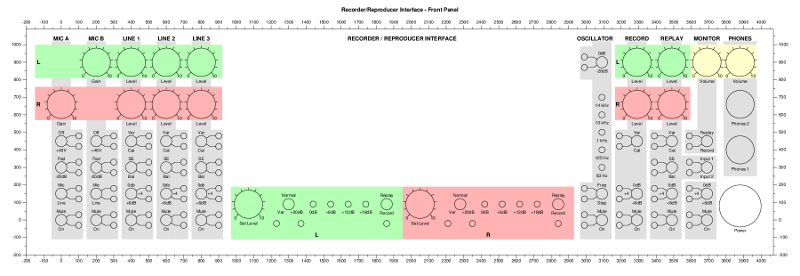 A larger version of this image is here.
A larger version of this image is here.
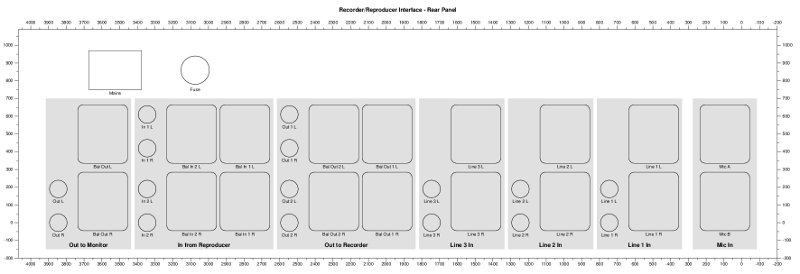 A larger version of this image is here.
A larger version of this image is here.
Well, needless to say, this was a quite major project. It ended up taking 5 years to
complete! I hope one day to get around to finishing a full description of this thing
with complete circuit diagrams and explanations of why it does what it does and how.
There is nothing innovative here, of course, but I learned a lot and maybe some of it
would be useful to someone else. Below are some photographs taken during its construction
(roughly in time order) ...
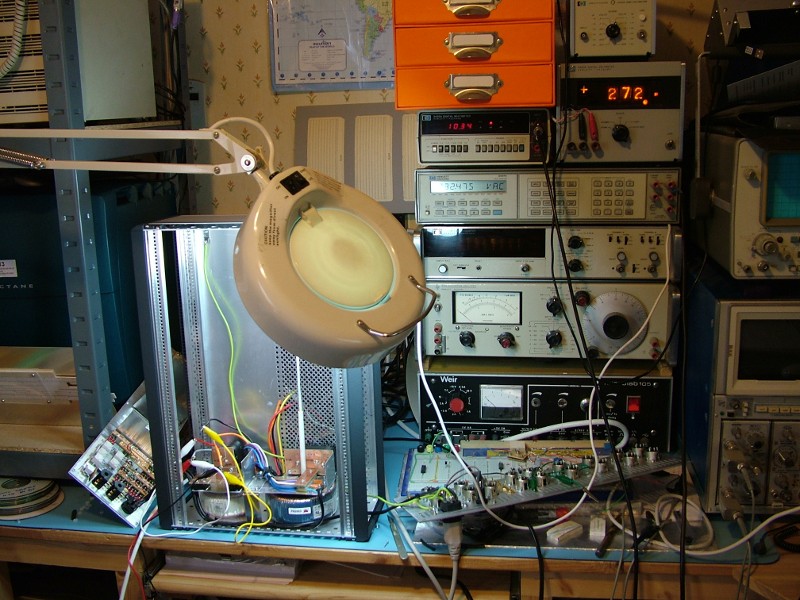 Fairly early on, starting to assemble the power supply. Front and rear panels
have been drilled and mostly assembled already.
Fairly early on, starting to assemble the power supply. Front and rear panels
have been drilled and mostly assembled already.
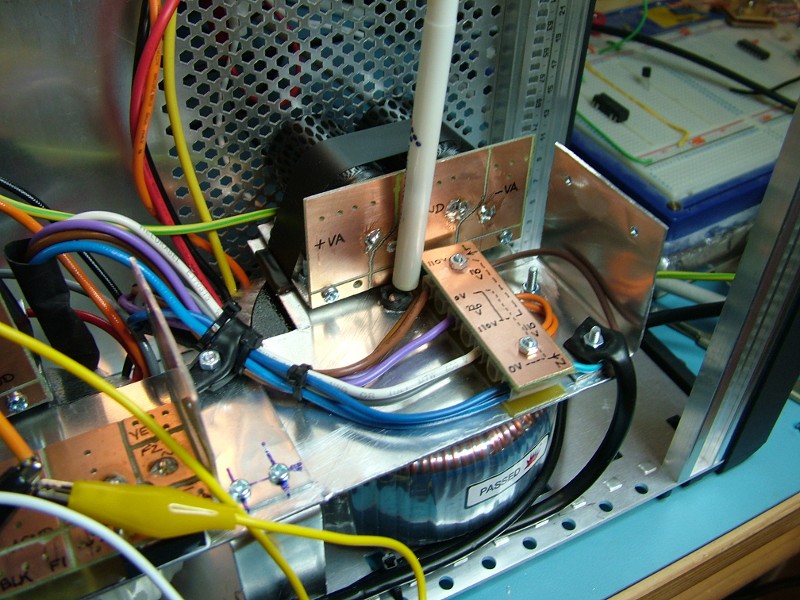 Close up of one of the two transformers.
Close up of one of the two transformers.
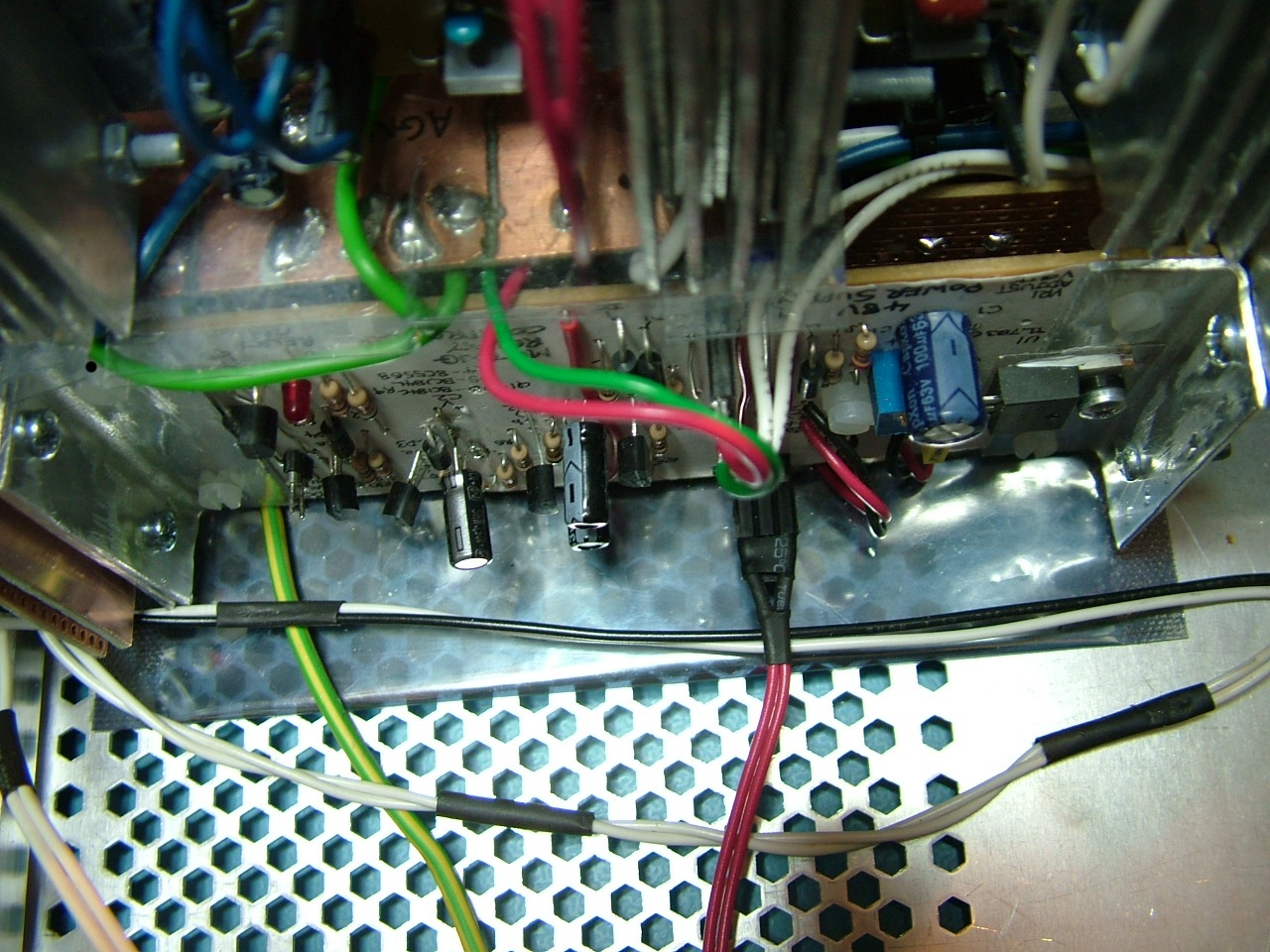 48V power supply and meter protection relay controller.
48V power supply and meter protection relay controller.
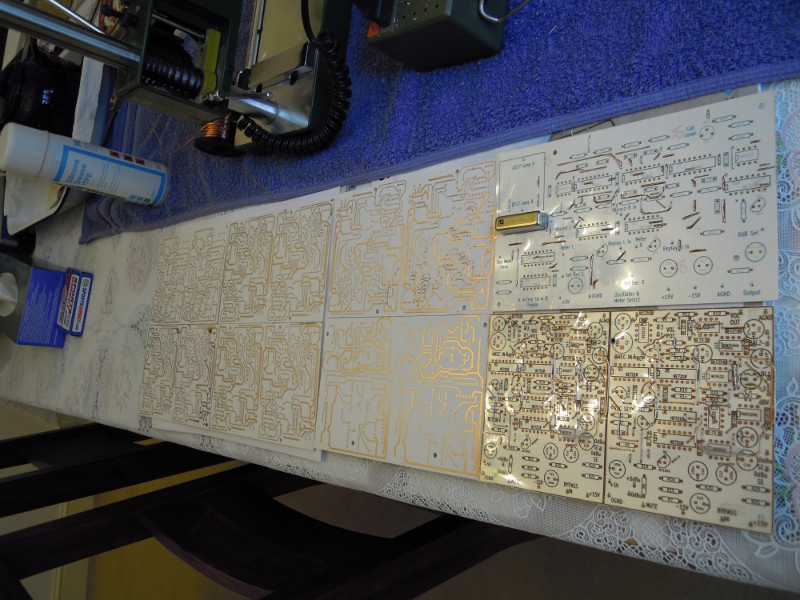 All the boards etched. Some of them have been drilled and are waiting to be stuffed.
All the boards etched. Some of them have been drilled and are waiting to be stuffed.
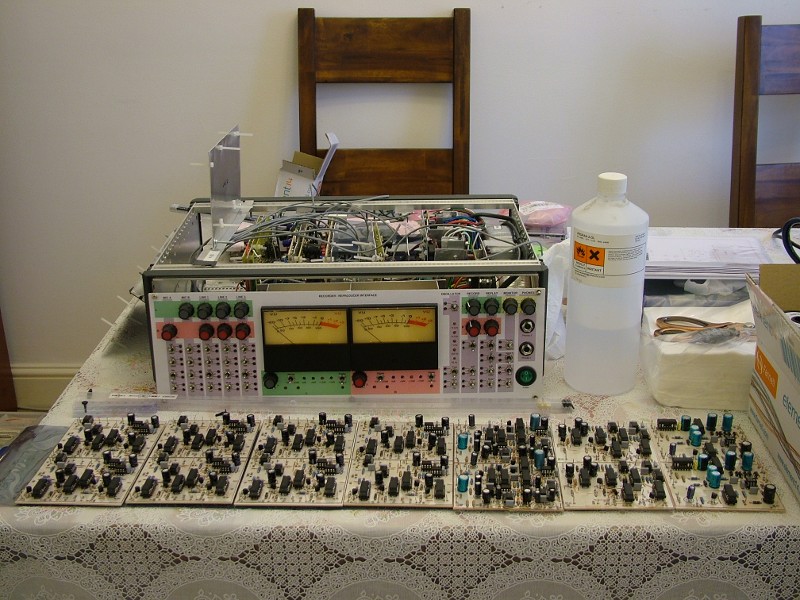 All the boards have now been stuffed. Some are in the chassis. Those are "proper" VU
meters, by the way -- Modutec devices from a sadly defunct Studer A800, courtesy of "Heinzmen"
(who has a very interesting website here.)
All the boards have now been stuffed. Some are in the chassis. Those are "proper" VU
meters, by the way -- Modutec devices from a sadly defunct Studer A800, courtesy of "Heinzmen"
(who has a very interesting website here.)
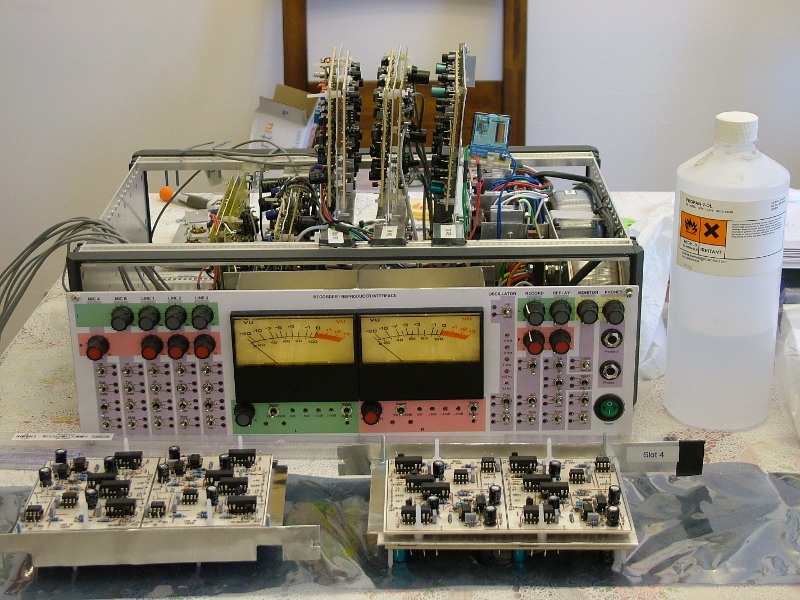 Boards mounted to plates ready for installation in the chassis.
Boards mounted to plates ready for installation in the chassis.
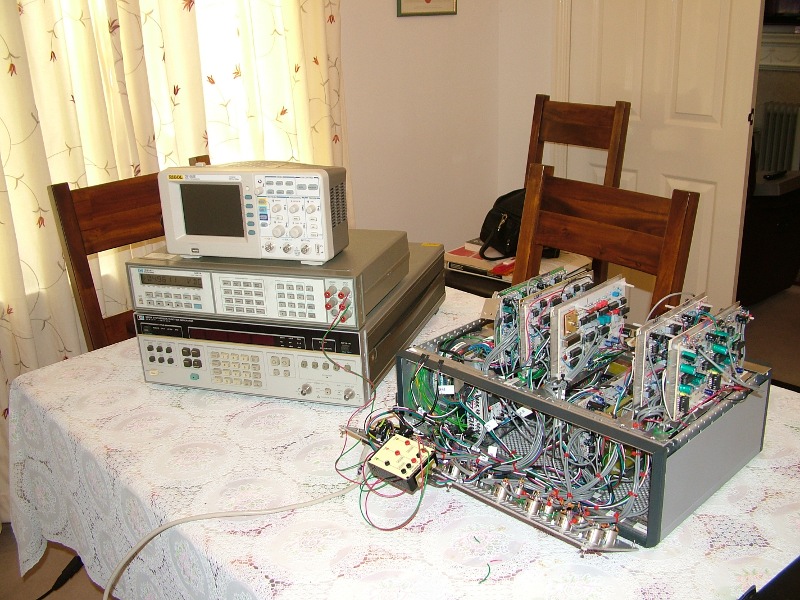 All boards mounted on plates. Some boards raised for test.
All boards mounted on plates. Some boards raised for test.
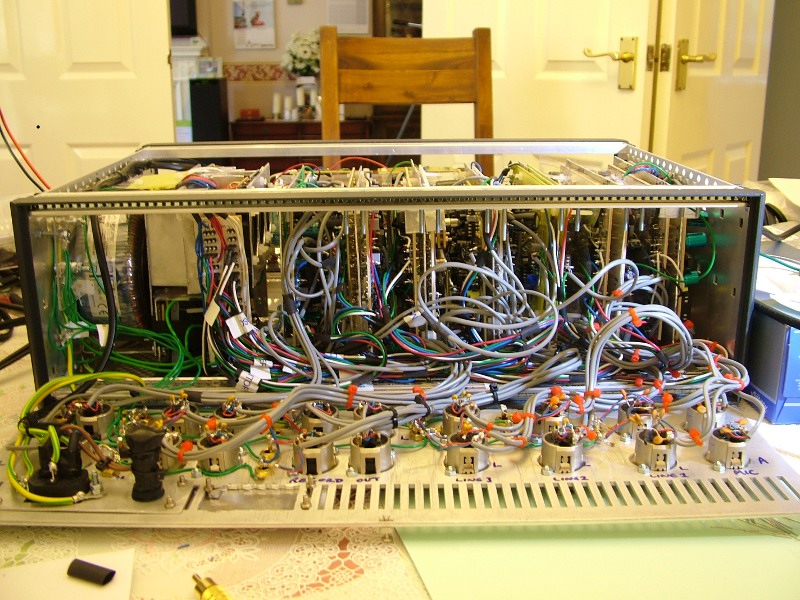 View from the rear of the almost fully assembled system.
View from the rear of the almost fully assembled system.
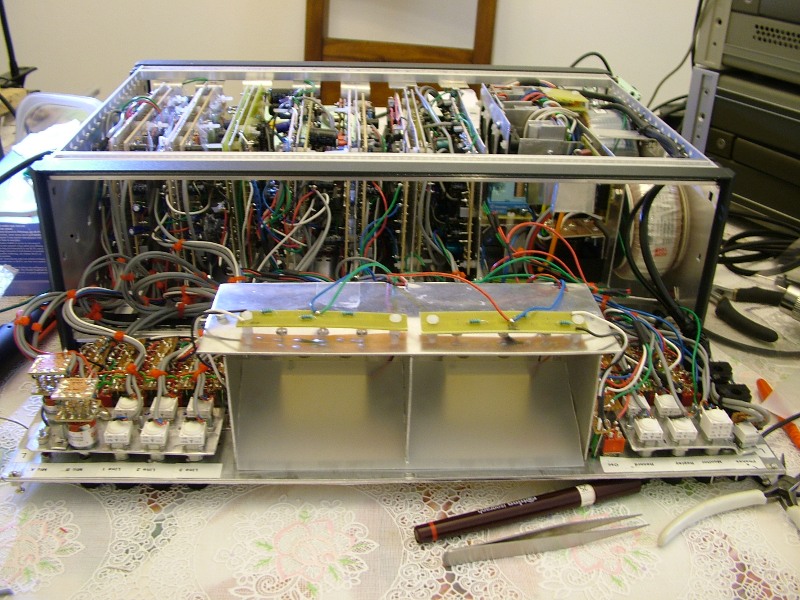 View from the front. Note the boxes with lighting for the VU meters.
View from the front. Note the boxes with lighting for the VU meters.
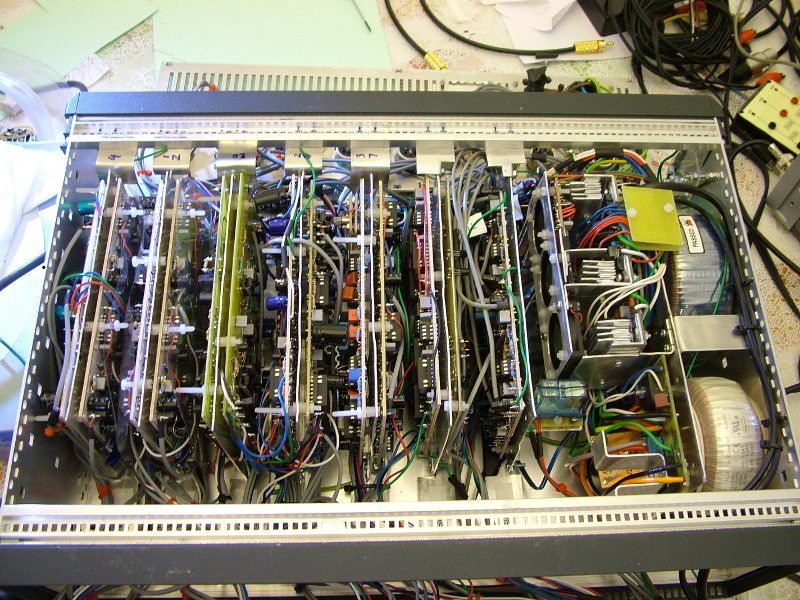 Top view. The "old" fan cooled power supply is on the right. This proved to
be too noisy (which I should have known from the start) and was later replaced
with a fan free design.
Top view. The "old" fan cooled power supply is on the right. This proved to
be too noisy (which I should have known from the start) and was later replaced
with a fan free design.
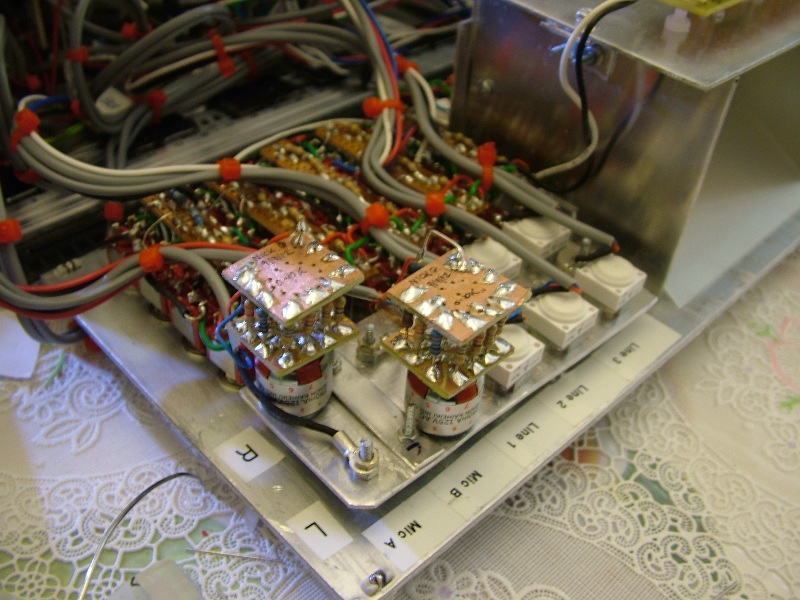 Switch based microphone amplifier gain controls.
Switch based microphone amplifier gain controls.
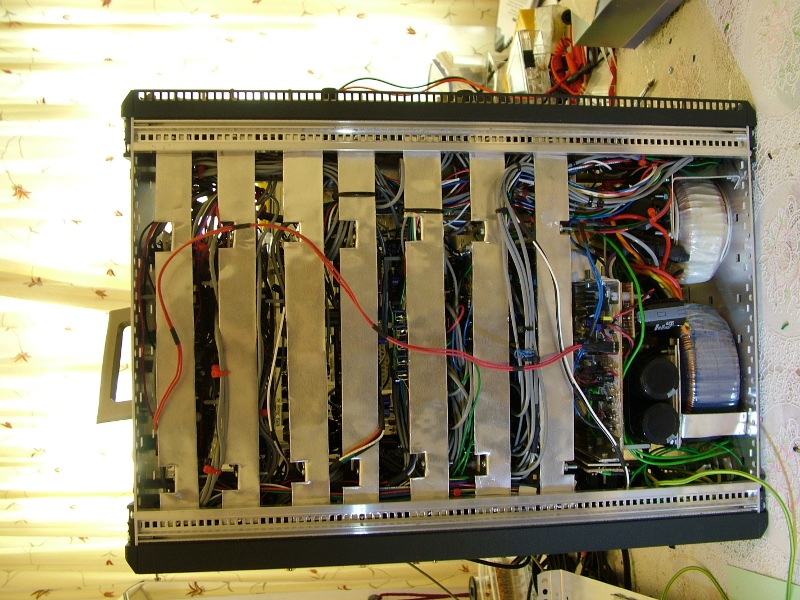
View from underneath.
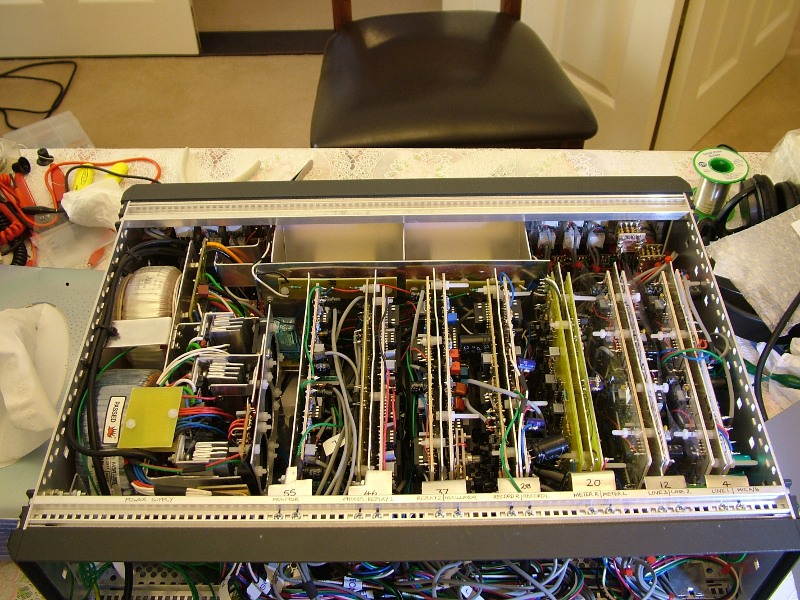 Another view from the top.
Another view from the top.
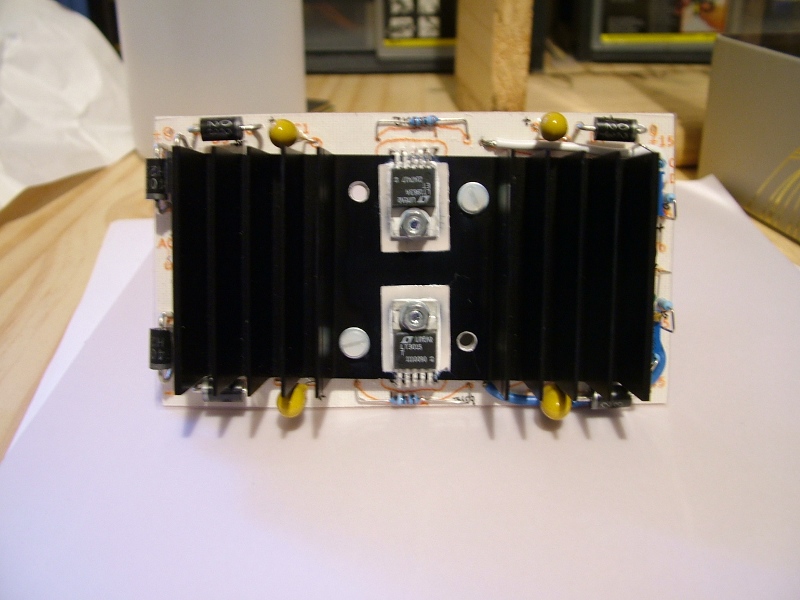 The new power supply regulator board. Much simpler, and with no fans, this
uses Linear Technology regulators rather than the old standby 78xx/79xx parts.
The new power supply regulator board. Much simpler, and with no fans, this
uses Linear Technology regulators rather than the old standby 78xx/79xx parts.
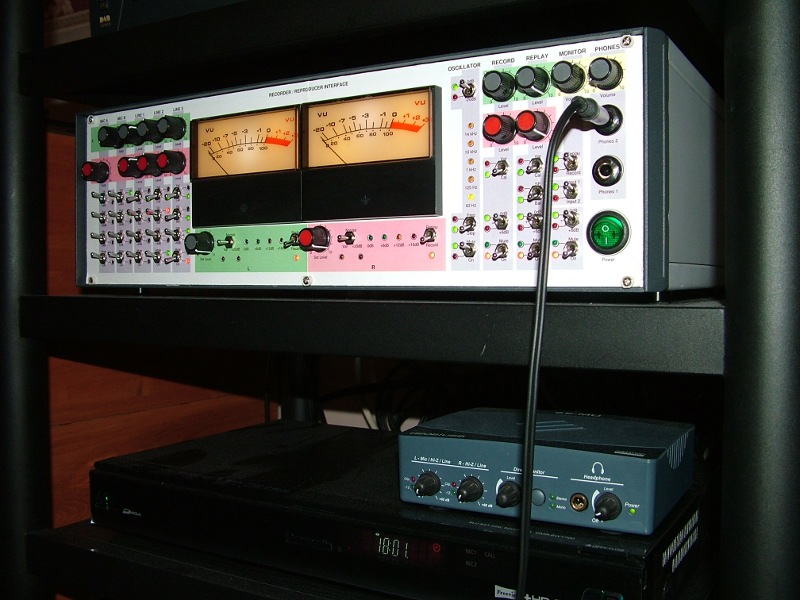 The finished device in use.
The finished device in use.
The RRI has now been in pretty frequent use for over a year without any problems. It does
what I intended and is really flexible. There were certainly much easier ways to get most
of the same job done, but all in all I am very happy with this project. Total cost was
somewhat less than £1000, which sounds a lot, but it comes to £200/year ... it is possible
to spend more than that on a Sky TV subscription, so I don't feel too bad about it.
The RRI is a quite "old fashioned" device, of course. All construction is done with
through hole components, circuit boards are all single sided (double sided is possible at
a stretch with home etching), and there is almost no digital circuitry (the oscillator
uses a ring counter for the frequency selection function, but that is about it, apart
from monostables in the peak level circuit). The design with relays on the cards would
lend itself to microcontroller control, but there was never any intention to use programmable
devices in this system. The components used are also mostly quite elderly -- lots of NE5532s,
although a lot of THAT Corporation devices are also used, which are somewhat newer.
If I were to do another DIY audio project, I'd try to use a microcontroller (required for
remote control if nothing else) and some other modern devices. A very nice DIY pre-amp
design based on a microcontroller and programmable gain amplifiers is
this one by Mark Hennessey.
Go to top ...
2010 - 2014 - Computer Based Audio
The time seemed ripe to return to this ...
Some Background Waffle
Arguably, the biggest change in audio technology in the last 40 years is the arrival of the
general purpose computer (a.k.a. the "PC") as a "universal device" capable of storing,
processing and replaying digital audio -- treating it as "just another type of data".
While PCs with CD-ROM drives at the very end of the 1980s were able to
replay analog audio to headphones to
entertain users while they worked (!), actually feeding the digital audio as data
through the system (potentially processing it as it went) was a much tougher proposition.
The first machine I used that could do this was a Silicon Graphics Indigo workstation back
in 1991. This may not have been the first reasonably priced (by the standards of the time)
general purpose machine that could do this, but it must be close.
By the early 1990s it was clear even to relatively dense people like me that Moore's Law
would lead to computers of one sort or another displacing just about all special purpose
devices in the audio and video fields (and pretty much everywhere else).
By the turn of the century, this change was well
underway (if not almost complete) with all "big iron" solutions (such as Studer tape machines)
on the way out (if not already gone). As I write this (late May 2014), Moore's Law is
itself on the way out (its most useful consequences started to run out 10 years ago), but the
changes it brought are here to stay.
The use of lossy coding schemes for digital audio, exploiting the psychoacoustic phenomenon
of masking to reduce the size of audio data by an order of magnitude, was first proposed in 1979
and the first implementations appeared in 1989. By 1995, these ideas had spawned MP3 (and many
competing similar formats appeared around the same time), the first MP3 player
arrived in 1998, and the rest is history, as they say.
Sufficiently fast, cheap, compact computing power and lossy compressed formats, along with
first miniature disk drives and then flash memory, allowed large collections of music to be stored
on portable devices (and, ultimately, the now ubiquitous "it does everything" device -- the "smartphone").
Music is now downloaded or streamed over the Internet to general purpose or special purpose computers
(iPods, MP3 players, smartphones, etc.) much more frequently than physical media (CDs, SACDs, whatever)
are purchased. Physical media are essentially obsolete.
Between the late 1990's and the late 2000's computers (and related devices) had grown fast enough
and capacious enough to store and process large quantities of audio in lossless formats. The computer
as a "source device" for music in high quality systems was by then a reasonable proposition. In fact,
it was a compelling proposition in many ways.
The key "selling point" is ease of use and convenience. Once a music collection is stored on a computer
based audio system (which includes special purpose "music server" systems), the whole of it is accessible
within seconds. You can search for a specific artist, album, work or track. You can also browse the whole
collection from your armchair using a tablet or the inevitable smartphone. This is not a small thing --
pretty much everyone who goes down this route finds they are listening to the music they have bought a
lot more than they did when they had to dig out a physical CD and put it in the player. Maybe we are
all just too lazy! When you reach several hundred CDs or more, though, even recalling what you have is
not so easy. Convenient searching and browsing makes things accessible again.
It seems to me that there are at least four ways of putting together a computer based "audio source"
system, and no doubt there are more.
- Buy a special purpose "music server" system. Such systems (which may include speakers and
be complete in themselves) are available from the likes of Sonos
and Brennan. Higher end traditional hi-fi companies such
as Naim, Meridian and Cambridge Audio (and, no doubt, almost all the rest by now) offer products
in this space. Most of them use wireless networking to deliver a multi-room solution. Costs vary
widely, as you might expect.
- Use a single, local, computer directly as a source. For example, plug your laptop in to your
hi-fi system, and use it to replay music files stored on that computer. For reasonable quality,
it is likely that an external DAC or "soundcard" will be needed. Most of the "usual suspects" in
the hi-fi industry make DACs now (usually USB attached). Again, prices vary widely. Soundcards
with ADCs and well as DACs are readily available from many manufacturers for the "home studio"
market, and many of these have excellent specifications.
- In a very similar vein, just plug your smartphone in to your hi-fi. Or buy a special purpose
audio "dock" with built in speakers, and be done with all this ridiculous hi-fi nonsense!
- Put together your own "music server" system based on commodity hardware and open source
software. This is quite feasible for technically competent people, as we shall see.
Whichever solution is chosen, there are some important considerations that are common to all of these.
- Any local computer must be as nearly silent as possible. Background noise sets the low end of the
dynamic range for serious listening. This rules out computers with fans -- which is still almost all
of them. You could try to put the machine in an acoustic isolation box of some kind, but that is a
last resort! Even hard disk drive noise is noticeable, so ideally, the machine would have solid state
disks. Hard disks may be quiet enough (most of the time) to be acceptable though (although
I do notice them clicking away). An example of a machine
that meets these requirements would be an Apple Mac Mini with solid state drives. (Mac Minis
do have fans ... but under normal loads -- such as playing music files, or streaming video --
I have never heard my example use them. Your mileage may vary.)
- Assuming you have an existing CD (or other physical media) collection, you will need to "rip" this
material to audio files. There are several points that spring to mind here:
- It is likely to take a very long time to actually do this if you have a large collection. It
took my wife and I over three years to rip our CDs and LPs by doing it when there was spare time
and the mood took us!
- Just "ripping" as such is not necessarily the end of this process. There is also the issue
of consistent "tagging": adding metadata that allows the digital collection to be properly
organized and searchable. The automatic metadata added during ripping by looking up disc
data over the Internet is often good for non-classical music, but for classical music,
the results are often less than satisfactory. Getting consistency involves a lot of extra
work with a tag editor. Consistency is key with computers: if you want to find everything you
have by J. S. Bach, it had better all be tagged as "J. S. Bach" and not partially as "Bach, J. S.",
"Johann Sebastian Bach" and/or any other mixture of words!
And then there's the artwork ... if you don't or can't get this at the
point you "rip", then assembling that is another significant task. For LPs, the only way I know
of doing this is to get out a camera ...
- Standard metadata tags are much more appropriate for non-classical music than they are for
classical. The best way to use the available tags for classical music is debatable, but one
approach is to use "Artist" to hold the composer and "Album" to hold the name of the work. There
is a standard "Composer" tag, but it isn't presented by default in most (all?) player
software.
- Some older MP3 players do not parse metadata ... they present a hierachical file system view,
so if these devices are important, the individual audio files must be grouped in to folders (for
an album, say), perhaps with a higher level too (for artists, say). The easiest time to do this is
when ripping, although, if necessary, writing software (in Python, for example)
that reads the metadata in all the
audio files of a collection and generates an appropriate file hierarchy is not very hard.
- Astonishingly, "ripping" CDs (the ones you bought with your money and that will remain in
your possession, listened to only by you on your equipment),
and any other process that converts music from one format to
another, is currently illegal in the U.K.! I believe that legislation will be passed
in June 2014 (next month as I write) that will rectify this insanity.
I also believe that the same 1988 legislation that makes ripping
illegal also limits the length of time you can "time shift" broadcasts to 28 days and requires
that time shift recordings be deleted after a single viewing. Presumably, PVR devices sold in the
U.K. should enforce these requirements by technical means! Obviously,
they don't. Just about all other countries have more sensible (and permissive) legislation.
Thankfully, we in the U.K. are finally about to catch up (to some extent, anyway).
Considering the number of devices
which require this 1988 law to be broken to work at all, it isn't surprising that, as far as I
know, it has never been enforced. Note that this is a completely different issue from
illegal downloads, illegal file sharing, copying media you haven't bought
and other copyright infringements. That is quite another can of worms ...
- Since getting your music collection in to a form usable by a computer based system is likely
to take a lot of effort, it is essential that you don't lose the end result (say as the result
of a disk crash -- which isn't exactly unheard of). The digitized collection should be stored
on a redundant disk system of some kind (at its simplest, a mirror pair) and there should
be provisions for backing it up. Only with redundant storage and multiple backups can
you be confident the whole thing won't just evaporate one day.
- You will need to choose an audio file format to "rip" to. Given the very low cost of disk
storage and the significant
effort involved in ripping, it would seem that a losslessly compressed format
would be a wise choice. Such a format can be transcoded to other formats, including
lossy ones (such as MP3), as needed. This will give the best quality and flexibility. Lossless formats
include FLAC, Apple Lossless (ALAC) and Monkey's Audio. There are others ...
- The most appropriate file format depends on the devices and software you intend to use. Apple devices
do not support FLAC directly. Other devices will not support ALAC ... And so on. Transcoding can solve
these problems without quality loss (between lossless formats), but it costs time and reduces convenience.
- You will need to take a view on how reliant you want to be on "third party services". If you decide
you want to use a streaming service (perhaps because you don't already have a large collection on
physical media) you will obviously be entirely dependent on a third party! Such services are very
popular and probably will be the most used "source" in the near future (they already are in Scandinavia).
Spotify is the most popular
provider, but there are plenty of others. Qobuz offers material in both CD quality and 24bit/192kHz,
so quality isn't necessarily an issue.
- If you purchase music through
"downloads", you may or may not have a possibly unexpected reliance on a third party (or two). If you
actually download a music file to a machine you own, you won't have any such issue.
If you use "cloud services"
(e.g. Amazon Cloud Player) you may be in the same position as with a streaming service.
It is theoretically possible that music you
think you have "bought" will turn out to not be accessible if you go on holiday, for example, because
you have actually only bought the right to access that music in certain territories. To be honest,
I'm not aware that this sort of thing has ever happened, but it could, in principle. It reportedly
has happened with e-books. Beyond this, there
is the whole question of what would happen if the company you "bought" your music from goes bankrupt
or decides they don't want to be in this sector anymore.
In the real world,
as far as I can tell, many people do whatever Apple iTunes lets them do, in whatever way iTunes
wants them to do it! This seems to be the path of least resistance -- and, indeed, the only (reasonable)
path if you rely on Apple hardware (iPods, iPhones and so forth).
Go to top ...
What I Ended Up Doing
In 2010, I decided to have a second go at a computer based audio (source) system. I made these decisions
(for good or ill):
- Use commodity hardware, open source software and open file formats.
- Don't spend much money on it!
- Don't rely on third parties for content. (Initially, anyway).
- Configure things with a reasonable amount of redundancy and backup.
- Allow for a multi-room configuration.
Based on this, my system is built around
Logitech Media Server (LMS) software
and Logitech Squeezebox hardware or software emulations of this. This hardware and software originated with a
company called Slim Devices, bought by Logitech in 2006, and discontinued by them in August 2012. Being
open source, however, the software lives on, and second hand hardware can be picked up on E-bay for not
a lot of money. Media Server is written in Perl and will run on just about anything. I have used two
different compatible software players:
- SoftSqueeze: Written in Java with a pretty GUI, but now unsupported.
- Squeezelite: Command line player which supports "high resolution" formats up to 24bit/384kHz(!).
There is also SqueezePlay, which may be the best supported of all. That is written in Lua.
LMS will support the Spotify streaming service (which I don't currently use -- but may one day)
and Internet radio (although adding stations requires
the actual stream address -- not always easy to find, although
this site is a good source
of them -- and is slightly painful).

Where the music lives these days ... Boring to look at, but very effective.
A pain in the posterior to set up though.
My current computer based audio source system comprises the following:
- LMS running on an IBM/Lenovo M55 computer (upstairs in my home office) under Ubuntu Server
12.04 LTS.
- Mirrored 1TB disks in the M55, holding the audio library (/audiolib).
The audio library holds the primary version of the collection as FLAC files.
- 1TB Seagate USB disk to which the audio library is automatically backed up daily
(using rsync).
- An MP3 format secondary version of the audio library generated from the primary version by
Robin Bowes's flac2mp3 script.
This is useful for some portable audio devices.
- A Squeezebox Classic (SB3) device in the listening room attached to the main audio system
via the RRI. This uses wireless networking and is entirely silent. Sound quality when using
it is excellent. This cost less than £100 from E-Bay U.K.
- Squeezelite software player on an Apple Mac Mini, attached to the main audio system. This
Mac Mini is also used for streaming video services. Audio is played out through a Creative
Labs EMU-0202 USB "soundcard".
- SoftSqueeze software player on a pair of IBM Thinkpad T60 laptops (running Ubuntu 12.04). These
usually use another Creative Labs EMU-0202 USB "soundcard".
- Fancy remote control via the
Orange Squeeze
application on a Samsung Android tablet. This is very
pretty with a nice display of all the artwork associated with an album. This "talks" with LMS
over the (wireless) network to get its job done.
- Alternative fancy remote control using
iPeng on an Apple
iPhone 4. Also very nice ...
Tools used in creating the audio library from CDs and LPs were:
- Exact Audio Copy ripper on Windows XP
(at the start of the project). This is probably still the best available CD ripping program.
FLAC output is supported.
- Mp3tag tag editor on Windows XP (also at the start
of the project). As with Exact Audio Copy, this is probably the best tag editing program
available.
- Sound Juicer ripper on Ubuntu Linux.
This works very well ripping to FLAC.
- Puddletag tag editor on Ubuntu Linux.
A worthy alternative to Mp3tag.
- Audacity audio editing software on Ubuntu Linux.
This was used with a ReVox B-795 turntable, a
Pro-Ject Phono Box pre-amp and
a Creative labs EMU-0202 USB "soundcard" to digitize LPs.
There are many, many alternatives to the software and hardware I selected for this computer based
audio system (perhaps too many). I'm very satisfied with these, however. The system is extremely flexible,
and has very few built in limitations (if more space for music is ever needed, I can just add more disks or
move to larger ones). It is secure against (at least some) hardware failures, and is not at all expensive
(certainly not compared to many specialized music server offerings -- and definitely not if you need a
server computer anyway for other purposes).
That said, it isn't exactly a turnkey solution, and I can quite understand people who want one of those.
The hardest thing by far though in this project was just digitizing all the physical media
in the first place (and photographing the cover art -- although that is probably largely my fault for
not getting the pictures off the Internet when ripping), then getting all the metadata tags
properly sorted out. This is a big job if you have a large collection
and there is no way around it (if you want to keep your existing collection)
no matter what other components and systems you select.
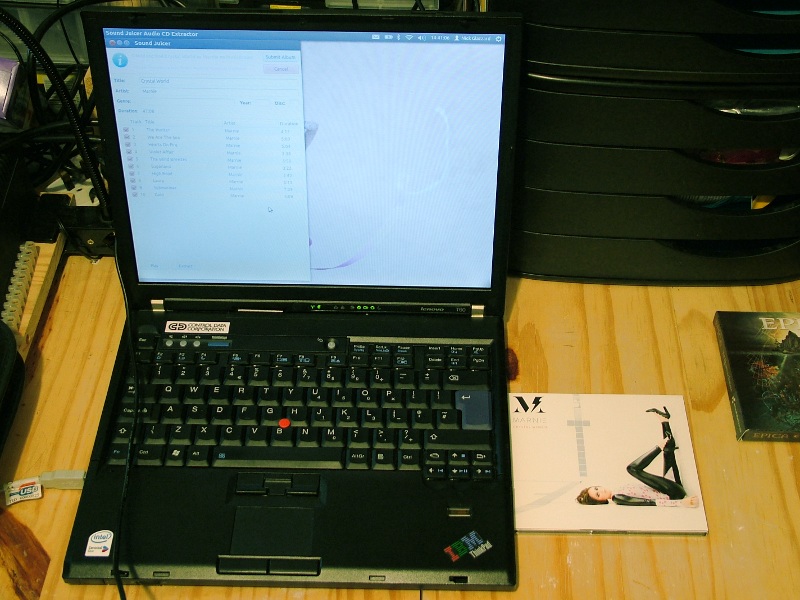
A crime being committed in the U.K.! Ripping CDs that you own and that will remain in
your possession was made illegal by a law passed in 1988. It will become legal some time
in June 2014. Just as well, since a large percentage of the population has broken this
law and many people own devices that just can't work without breaking it. I have no idea
what the motivation behind making "format conversion" illegal was. I could believe that
record industry executives wanted us to pay to download all the music we already owned
on CD ... but 1988 was over a decade too early for that to be the real reason.
The convenience and accessibility that results from seeing such a project through, however, is well
worth the time and trouble involved in doing it. You will not want to go back to loading CDs into
a player ever again!
Go to top ...
2014 Main System
This lives in the listening room (a.k.a. living room). It is used for all television and movie replay
sound as well as for music proper, so it is very heavily used. Strictly stereo though!
The Meridian DSP-5000s and G91DH (top shelf) are
still at center stage, but most of the music is sourced via the Logitech (Slim Devices) Squeezebox Classic
perched on top of the left DSP-5000 (the signal passing through the RRI on the second shelf down).
Radio
is still primarily from the Arcam Alpha 10 DAB tuner, although Internet radio is available via the
Squeezebox or the
TuneIn Radio app
on a Sony NWZ-F886 Web enabled, Android based, Walkman (which is much more convenient for this
particular purpose). The Behringer DEQ-2496, sitting on top of the DAB tuner, is used for room
equalization, as explained at nauseating length in this page and is now
a critical part of the system.
The Studer
A-812 and a Creative Labs EMU-0202 (+ Mac Mini) work with the RRI for live recordings via a pair
of Audio Technica microphones. I still can't play a note, but I mess about with sound effects and
my wife has been known to sing a bit. The R2R Remotes infra-red receiver for the A-812 remote control
is next to the Mac Mini on top of the G91.
A Panasonic Blu-ray disc player and high definition hard
disk recorder is on the third shelf. This works with a 50 inch Samsung Plasma display (a bargain at
£550 when we bought it) to show SD and
HD content (now available for the major Freeview terrestrial channels in the U.K.). This is something
of an improvement on the Toshiba set and Sanyo Betamax of the early to mid 1980s (although they were
good in their time). One issue with the plasma TV is that it makes a noticeable buzzing noise -- this
can be quite annoying (depending on your mood). It also makes a lot of radio
frequency noise! More on this below ...
Sennheiser HD-600 headphones are in the black box between the DSP-5000 and the
equipment rack.
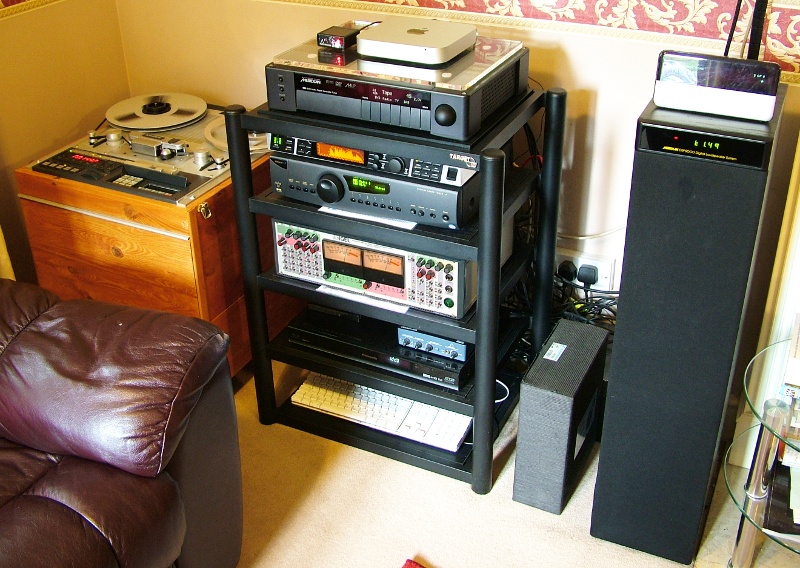 Overview of the main audio system as it is today (late May 2014).
Overview of the main audio system as it is today (late May 2014).
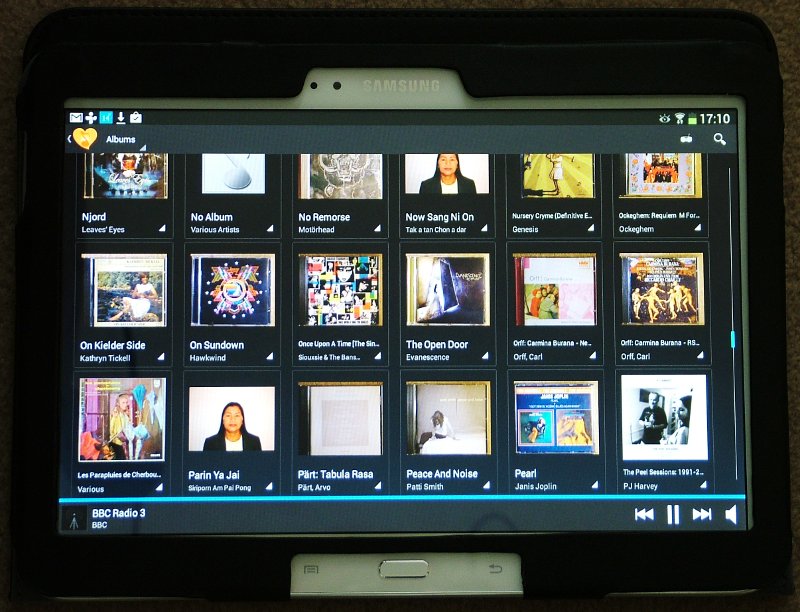 Orange Squeeze on a Samsung Galaxy Tab 3 10.1 Android tablet (GT-P5210). This is a lovely way of
accessing the computer based music library.
Orange Squeeze on a Samsung Galaxy Tab 3 10.1 Android tablet (GT-P5210). This is a lovely way of
accessing the computer based music library.
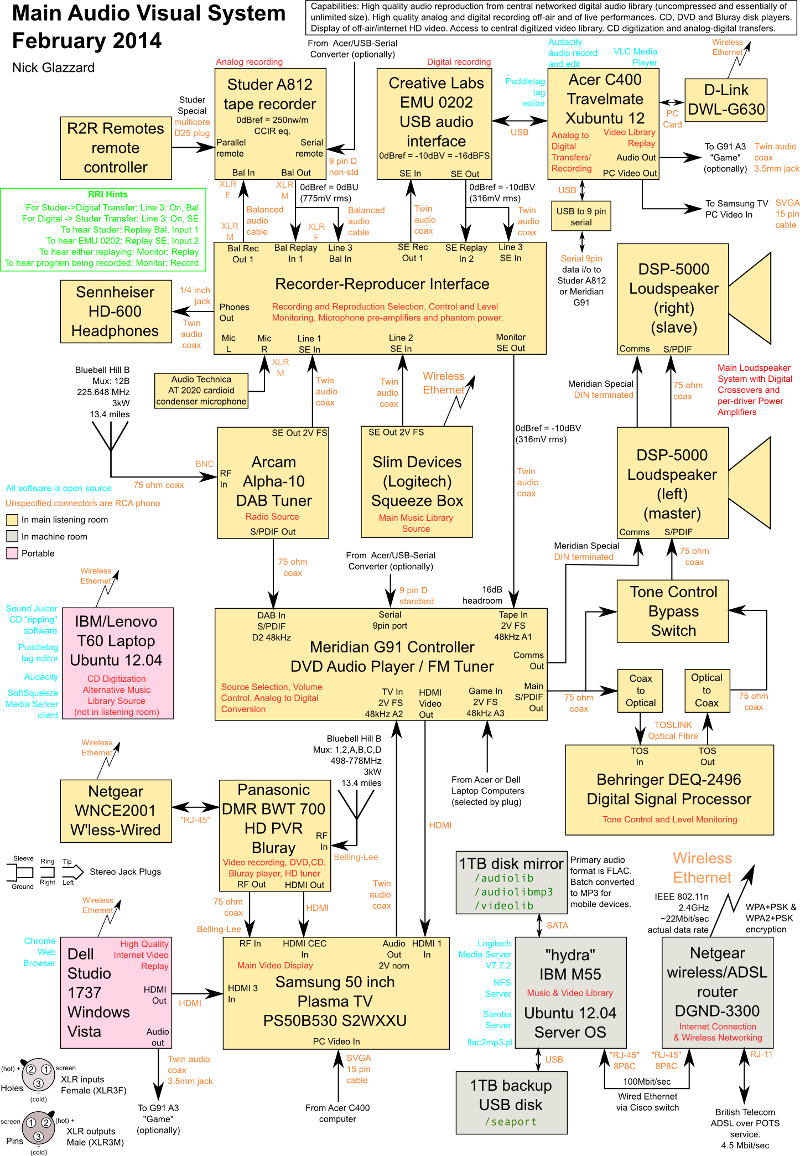 Just about everything there is to say about this! Except the Acer laptop has been replaced by an
Apple Mac Mini that I got for free as part of a redundancy settlement.
Just about everything there is to say about this! Except the Acer laptop has been replaced by an
Apple Mac Mini that I got for free as part of a redundancy settlement.
Go to top ...
2014 Office System
This is made up almost entirely of Studer/ReVox equipment. The A7X collection is lined
up on the cabinet: A77 tape machine, A76 tuner and A78 amplifier. As noted above, much work has been
done on the A77 and A78. The A76 has not been touched so far ... It is a superb non-synthesised tuner,
designed by Ernst Mathys.
It has what I believe is a quite unique feature: a linear tuning
scale. Look at any other non-synthesised tuner (one with a "real" tuning knob) and you will find the
scale is not linear. The A76 is very clever indeed.
A ReVox B225 CD player from 1984 is on the shelf above the A7X. Many polarized capacitors were recently
replaced in this to fix a number of issues that had developed. It now works perfectly. The EMU-0202
USB "soundcard" on that shelf can be plugged in to an IBM T60 laptop to replay anything stored in the computer
based audio library.
I recently purchased a ReVox B795 turntable at Tonbridge Audio Jumble for £200. This let me add the
LPs I have -- many from the Sobell radiogram days -- to the computer based audio library. The best
turntable I have had ... but it still can't descratch the disks!
The loudspeakers are British JPW Sonata bookshelf (literally in this case!) devices. These were reputedly
partly built by guests of Her Majesty's Prisons! They actually sound very good to me, driven by the A78,
of course. So called "budget systems" are really very satisfying. All you really need most of the time.
They cost all of £30 from E-Bay.
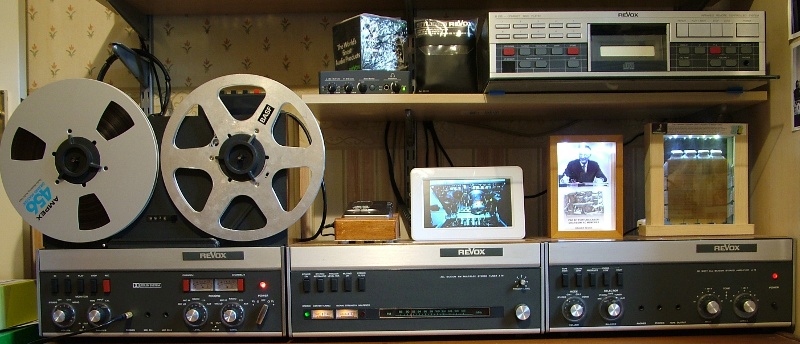
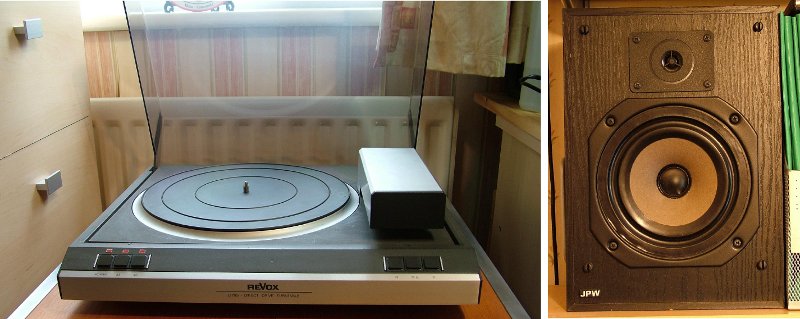
Go to top ...
2014 Portable Audio Devices
Since we spend some time in Thailand (and occasionally elsewhere) I have gathered a few portable
players of late (there is also the 1997 Sony TCD-D100 still available). I was very late getting in
to MP3 players (and similar devices), finally purchasing a Thai made Cube XV210 4GB in 2011. This
isn't a bad sounding player, actually. It doesn't parse metadata, though, so you have to have a
nice folder hierarchy to find things.
In 2012, I added a Sansa Clip+ and put a (Sansa) 32GB MicroSD card in it. This is almost
a perfect portable music player. It has a lot of storage space (enough for my entire collection in
MP3 format), it is cheap, it sounds very good, it can play FLACs, it is tiny, it has a fair FM
radio ... but it has one annoying problem. If you plug it in to a computer (to load new
music or just to charge it) when you disconnect it, it will display: "Refreshing your media".
With my music collection on a fullish 32GB MicroSD card, this take 2.5 hours! By the time it has finished
the battery needs recharging again! Now, I do have a workaround for this that almost always works:
recharge it "indirectly" using a battery pack (e.g. the Veho Pebble seen in the picture). It doesn't
"think" it has been connected to a computer, so it doesn't need to "refresh the media" it you do this.
Mostly. In spite of this problem (which you would never know about until you lived with it), it is a great
device.
I recently bought a Sony NWZ-F886 "hi-res audio" player. As mentioned above, this is an Android based,
Web enabled, device which can do things like access Internet radio. It also displays cover artwork,
can run Orange Squeeze and so far it hasn't needed hours to "refresh media". But it is early days,
so we shall see.
I usually use all these with Sennheiser CX-299 "in ear canal" headphones.
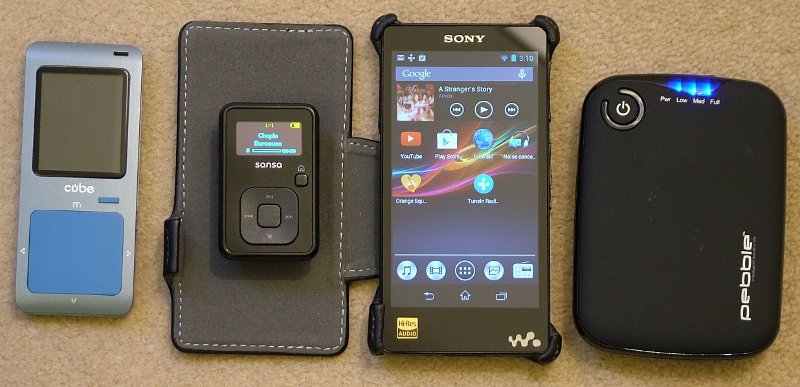
Meanwhile, we see below what defines "a music system" for a very large (and growing) percentage of
the world's population (the part that isn't totally occupied with rather more serious issues like not starving,
not being shot and not being beaten to a pulp by their husbands, anyway).
 Yes, you can ... But I won't ...
Yes, you can ... But I won't ...
I must say that I do find "ear bud" headphones uncomfortable after a short period of use. This is even
more the case with "in the ear canal" types, although they are good at reducing external noise.
My assessment
of sound quality using them is also very variable. Using the same equipment and the same music,
at different times and under different environmental circumstances, it can range from excellent to
terrible! Decent over ear headphones (e.g. the ancient and supposedly not too wonderful Sony MDR-V400s)
gives much better results for me. Your mileage may vary!
Go to top ...
The Future?
For myself -- perhaps "downsizing". I have no real plans to change anything in the
immediate future, but, if I did, less rather than more is likely.
If I did change things I would go down the DIY audio route again. I've been a happy Meridian
customer with the DSP-5000s for the last 15 years (and I still am),
but if I were to change them for something else,
it would be something I built myself (but, for the loudspeakers,
probably from a design by someone more expert than me).
I am convinced by the technical integrity
of Siegfried Linkwitz's designs. The LX-521, Orion
and Pluto loudspeakers are all fascinating possibilities. One thing I am certain of
is that active loudspeaker systems, of one kind or another, are the right way to go. These need
one power amplifier per driver with an active (analog or digital -- e.g. Behringer DCX-2496) crossover.
Passive crossovers belong to the 1930's and have no place in the 21st Century.
If I were forced to part with things, the RRI, A7X collection and A-812 would be the things I would
cling on to as long as possible.
Partly because I have expended my own physical and mental effort on them; partly
because the Studer/ReVox gear is so well engineered (and I really like the company).
I can't see me ever moving from a stereo system to a surround sound system. If watching movies
is the main application, then surround is a necessity -- it is a "no brainer". But for music
replay, it isn't clear it is the best answer. As far as I know, very little (if any) music
recordings are made in 5.1 or 7.1 surround. The whole surround thing also seems very ad hoc
to me with little theoretical basis. No doubt it doesn't need any if it sounds good, but ... hmmm ...
I would be very interested in hearing an Ambisonics system in action though. That does have
a sound (hah!) theoretical basis -- albeit with limitations and caveats that make it
doubtful that it can work in practice in quite the way the theory suggests.
I waffled on about this some more on this page. Surround
systems also have a very real practical difficulty for us: where do you put five or seven
loudspeakers and a
subwoofer (or several) in a normal living room? We don't have a dedicated "home theatre"
room and we never will.
I will very likely be making use of a streaming service in the near future. For anyone starting out
who doesn't already have a large physical collection, this has huge advantages as far as convenience
and availability of material goes. It also eliminates the "ripping effort" problem. True -- you are
then totally reliant on a third party (which I instinctively don't like), but they can't all go bust,
and if all you do is pay a monthly subscription, switching to another is not that big an issue. I
don't see how you can lose anything you have paid for. But I may have overlooked something!
Radio, as such, seems to be dying. At some point in time, FM will be switched off. In the U.K. this
has been indefinitely delayed, I am glad to say. But governments seem to want to discontinue it
(presumably so they can use the spectrum for something else, and raise money from it), so it is
very likely to happen eventually. DAB is of questionable value. At sufficiently high bit rates and
with a good signal it works well. DAB+ works even better. But, in the home, Internet radio is available
with better compression schemes and at much higher bit rates. I may be fooling myself, but I genuinely
think it often sounds better than DAB even at 192kBit/sec (the highest ever transmitted in the U.K.).
This seems to particularly show up when listening to violins. At
128kBit/sec, DAB is really poor -- obviously worse than decent FM. Internet radio (from the BBC, anyway)
is not totally reliable, however. In fact BR-Klassik from Germany is more reliable for some reason.
If anyone listens to AM these days,
they may find themselves in for a shock if they have a plasma TV ...
mine wipes out the MW band completely when it is on!
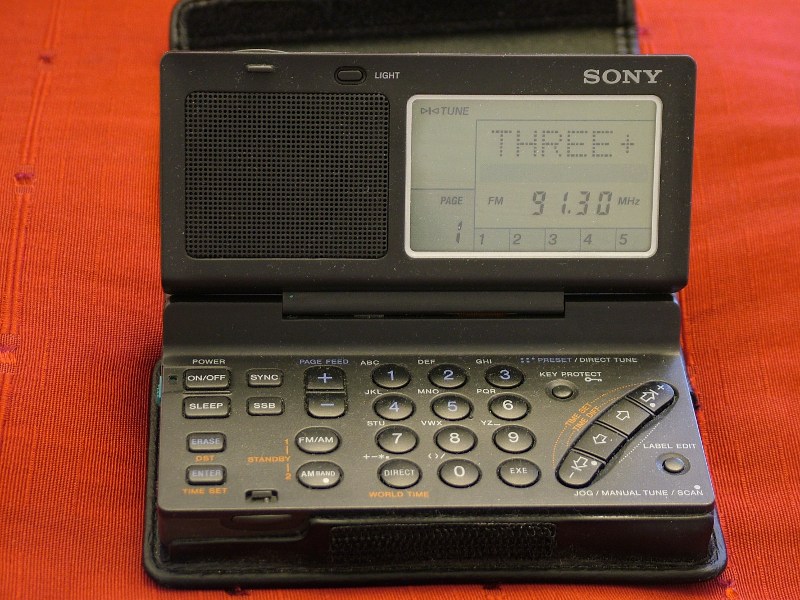
An excellent "state if the art" radio from the late 1990's -- a Sony ICF-SW100.
Another example of Sony at its best.
Given the likely demise of FM in the not too distant future and the massive radio frequency
intereference caused by plasma TVs and computer equipment wiping out AM reception, it may be
soon be much less useful than it has been in the past.
As to the world in general:
Home theatre with surround sound is doubtless much more of a growth market than
other areas of "high quality" sound reproduction. Although "highly convenient" versions of this that
avoid the multiple loudspeaker problem -- but, sadly, also don't really work -- are probably
dominant in the market.
"Hi-fi" as such has not had much currency with younger people for quite some time. It is amusing to note
that it is a hobby confined largely to middle aged (or older) males -- whose hearing is almost always
much poorer than young and female people! One of the ambitions of people of my generation was to get
a good stereo system. That hasn't been on the "to do" list of most twenty somethings since the early 1980's
though.
For those who are interested, where stereo is concerned, very good quality can be
obtained nowadays for not a lot of money (less than £1000 for sure), if you spend it
wisely (easier said than done). Paying more than that only
gets you these things:
- The ability to play very loudly without distortion. This isn't good for
your hearing --- or, very likely, for the neighbours sanity.
- The ability to reproduce deep bass. Also maybe not good for the neighbours! Much
attention to the listening room is needed for this to work well too.
- Really pretty cosmetics: lovely wood cabinets, polished metal, and so forth.
- Really high quality construction -- which may not have any audible consequences (at
least in the short term ... what happens as equipment ages may be another matter).
Very good reproduction has been
available for a price since at least 1970 and arguably from the late 1950s. Today,
more people than ever can afford to get it if they want it.
What has never been available before is the level of availability and convenience we have today.
That is new and really remarkable.
Quite recently (writing in May 2014), several companies have started marketing various products
as high resolution audio equipment and content. This is loosely defined, but seems to
potentially cover everything that goes beyond "CD redbook" specifications of 16bit/44.1kHz. It
seems like 24bit/192kHz is perhaps the most common "hi res" specification. I think it is fair
to say that this development is controversial. It is yet to be shown that "CD" standard audio
is inadequate as an end user delivery specification. It is certain that higher amplitude
resolution and sampling rates are highly desirable during music production where the
signal will be subject to all sorts of serial manipulations. The same controversy applied to earlier
"better than CD" specifications and media, such as SACD (with its bitstream technology) and DVD-A.
The issue is clouded by the fact that standard CD and "high resolution" versions are often
not made from identical source material -- they are mastered separately, with the "high resolution"
format seeming to often get more attention than the standard CD version! This was shown in
experiments where the "high resolution" material was fed through a "CD quality bottleneck" which
reduced the signal to 16bit/44.1kHz. The material originating from "high res" media still sounded
better and different -- because it was fundamentally different to start with! I suspect the
controversy will continue. One argument is that "high resolution" at least can't hurt, although "Monty"
at xiph.org has written a very interesting
article
pointing out that maybe it can! There is a lot more that I could say about this, but I'll refrain.
In summary, I think "CD quality" formats are quite good enough for all reasonable
domestic listening requirements -- if everything is done right.
The BBC also has "high definition" audio, which appears to mean 320kBit/sec MP3 quality streams. These
are usually (but not universally) regarded as being indistinguishable from CD quality uncompressed audio.
This should not be confused with "high resolution" audio (although I, for one, find the naming confusing).
This high bit rate material sounds better to me than 192kBit/sec DAB, as already noted.
Finally, it is possible to spend vast sums of money on audio equipment. Such expenditures can
in no way be justified by the pursuit of excellence based on established scientific and engineering principles.
It is possible to spend $100,000 to $300,000 on "hi-fi" ... in fact the sky is the limit. Perhaps
some of this is just down to conspicuous consumption. Many aspects of this seem to me to be interesting,
but disturbing, psychological phenomena, though. The worst of it is that some of the most expensive equipment
is also some of the poorest performing according to objective measures. There is a lot of "snake oil"
on sale here. The maximum price for a stereo audio system for a normal size room, justified by
engineering excellence, is probably less than £15,000 ... and that is surely quite enough. Beyond
that we are in to "luxury lifestyle" products ... or something more peculiar.
Go to top ...
Go home ...





























































